1. Introduction
High-speed flow (supersonic or hypersonic flow) over a surface with a compression corner typically features a separated boundary layer and associated shock waves, as illustrated in figure 1(a,b). The separation and reattachment shock waves can exhibit low-frequency oscillatory motion – a phenomenon that has extensively been studied under the class of problems referred to as shock wave/boundary layer interaction (SBLI; see, for instance, Beresh, Clemens & Dolling Reference Beresh, Clemens and Dolling2002; Touber & Sandham Reference Touber and Sandham2011; Clemens & Narayanaswamy Reference Clemens and Narayanaswamy2014; Gaitonde Reference Gaitonde2015; Murugan & Govardhan Reference Murugan and Govardhan2016; Estruch-Samper & Chandola Reference Estruch-Samper and Chandola2018; Gaitonde & Adler Reference Gaitonde and Adler2023, and references therein). SBLI studies generally consider a sufficiently developed boundary layer where the leading edge of the wall has little influence on the local flow dynamics in the SBLI region. In contrast, an SBLI-type scenario situated close to the leading edge of the wall exhibits distinct and complex flow features arising from interactions between the leading edge, separated and reattachment shock waves and separated boundary/shear layer, as illustrated in figure 1(c). The intersection of the leading-edge shock wave with the unsteady separation shock wave creates an intermediate shock wave. This shock wave systems sets the flow conditions over the separation region, and viscous interactions in the separation region can lead to large-spatial-amplitude and low-frequency oscillatory motion of the entire shock-wave system. In one class of such unsteady flows, the shear layer (i.e. the separated boundary layer) that forms over the separation region/bubble is susceptible to flow instabilities, and growth of disturbances arising from such instabilities leads to interesting unsteady coupled dynamics of the overall flow system. These types of unsteady flows are distinct from SBLI and are classified as shock wave/separation region interaction (SSRI) problems (Duvvuri, Kumar & Sasidharan Reference Duvvuri, Kumar and Sasidharan2023).
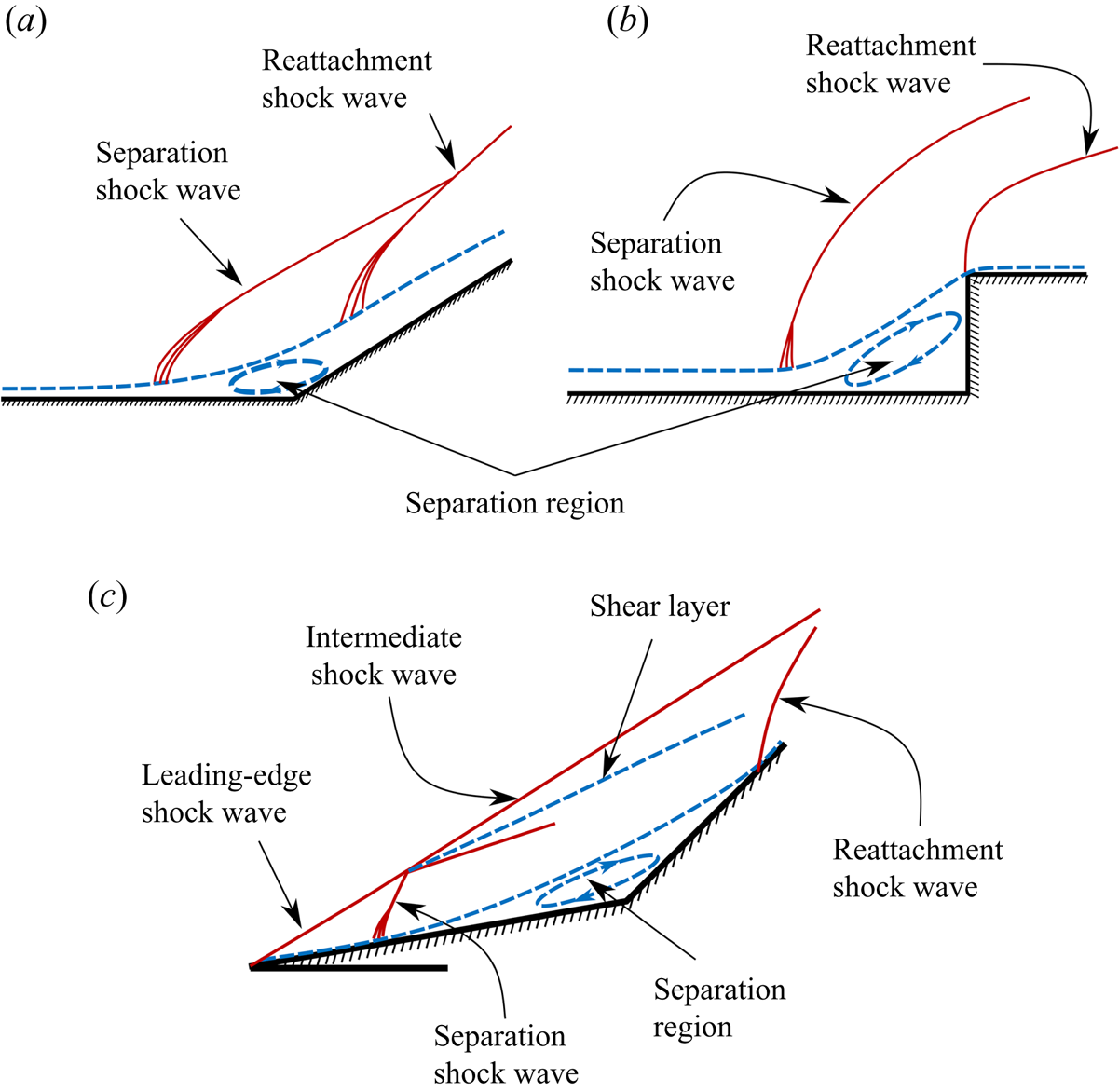
Figure 1. Schematic illustrations of different flows with SBLI and SSRI. (a,b) Formation of separation and reattachment shock waves when a supersonic flow is turned due to an inclined ramp or a forward facing step, respectively. (c) Interaction between the leading-edge shock wave and the separation region for a double ramp. Intersection of the separation shock wave with the leading-edge shock wave generates an intermediate shock wave and a shear layer, both of which are in the vicinity of the shear layer that envelopes the separation bubble.
High-speed flow over a double cone generates unsteadiness due to SSRI, and makes for a good canonical problem for a detailed study of the flow dynamics associated with SSRI. The double cone model comprises two adjacent right circular conical sections along a single axis (see figure 2). The model geometry is described by the two cone half-angles ![]() $\theta _1$,
$\theta _1$, ![]() $\theta _2$ and slant lengths
$\theta _2$ and slant lengths ![]() $l_1$,
$l_1$, ![]() $l_2$ of the conical sections. It is noted that the double wedge geometry is the two-dimensional (2-D) version of the double cone, where the conical sections are replaced by rectangular wedges of half-angles
$l_2$ of the conical sections. It is noted that the double wedge geometry is the two-dimensional (2-D) version of the double cone, where the conical sections are replaced by rectangular wedges of half-angles ![]() $\theta _1$,
$\theta _1$, ![]() $\theta _2$ and slant lengths
$\theta _2$ and slant lengths ![]() $l_1$,
$l_1$, ![]() $l_2$. Both double cone and double wedge configurations can be fully defined by three non-dimensional parameters, taken here to be
$l_2$. Both double cone and double wedge configurations can be fully defined by three non-dimensional parameters, taken here to be ![]() $\theta _1$,
$\theta _1$, ![]() $\theta _2$ and
$\theta _2$ and ![]() $\varLambda = l_2/l_1$.
$\varLambda = l_2/l_1$.

Figure 2. Schematic of the double-cone model. Fore-cone half-angle ![]() $\theta _1$, aft-cone half-angle
$\theta _1$, aft-cone half-angle ![]() $\theta _2$ and slant length ratio
$\theta _2$ and slant length ratio ![]() $\varLambda = l_2/l_1$ are the three non-dimensional geometric parameters that completely define the model.
$\varLambda = l_2/l_1$ are the three non-dimensional geometric parameters that completely define the model.
A special case of the general double cone configuration is the spike-cylinder model, where ![]() $\theta _1$ and
$\theta _1$ and ![]() $\theta _2$ are fixed at
$\theta _2$ are fixed at ![]() $0^\circ$ and
$0^\circ$ and ![]() $90^\circ$, respectively. The spike-cylinder geometry is defined by a single non-dimensional parameter, i.e.
$90^\circ$, respectively. The spike-cylinder geometry is defined by a single non-dimensional parameter, i.e. ![]() $\varLambda$. High-speed spike-cylinder flow has attracted considerable research attention since the 1950s (see Sahoo et al. Reference Sahoo, Karthick, Das and Cohen2021; Duvvuri et al. Reference Duvvuri, Kumar and Sasidharan2023 and references therein). Early experimental studies of the flow clearly revealed unsteady and periodic flow phenomena (Maull Reference Maull1960; Wood Reference Wood1962; Kenworthy & Richards Reference Kenworthy and Richards1975; Kenworthy Reference Kenworthy1978). As noted previously, the spatial extent of unsteady motions in the flow (for a certain range of
$\varLambda$. High-speed spike-cylinder flow has attracted considerable research attention since the 1950s (see Sahoo et al. Reference Sahoo, Karthick, Das and Cohen2021; Duvvuri et al. Reference Duvvuri, Kumar and Sasidharan2023 and references therein). Early experimental studies of the flow clearly revealed unsteady and periodic flow phenomena (Maull Reference Maull1960; Wood Reference Wood1962; Kenworthy & Richards Reference Kenworthy and Richards1975; Kenworthy Reference Kenworthy1978). As noted previously, the spatial extent of unsteady motions in the flow (for a certain range of ![]() $\varLambda$) can be much larger than unsteadiness observed in SBLI scenarios. Kenworthy & Richards (Reference Kenworthy and Richards1975) identified two distinct states of unsteadiness and labelled them as ‘pulsation’ and ‘oscillation’. Flow pulsation is characterised by large-scale unsteady motion of shock waves driven by a periodic growth and collapse of the separation bubble, whereas flow oscillation is a distinct, and relatively smaller-scale, unsteadiness of shock waves which is driven by flow disturbances in the shear layer that forms over the separation bubble. For given flow Reynolds and Mach numbers, the state of flow unsteadiness is determined by
$\varLambda$) can be much larger than unsteadiness observed in SBLI scenarios. Kenworthy & Richards (Reference Kenworthy and Richards1975) identified two distinct states of unsteadiness and labelled them as ‘pulsation’ and ‘oscillation’. Flow pulsation is characterised by large-scale unsteady motion of shock waves driven by a periodic growth and collapse of the separation bubble, whereas flow oscillation is a distinct, and relatively smaller-scale, unsteadiness of shock waves which is driven by flow disturbances in the shear layer that forms over the separation bubble. For given flow Reynolds and Mach numbers, the state of flow unsteadiness is determined by ![]() $\varLambda$. See Duvvuri et al. (Reference Duvvuri, Kumar and Sasidharan2023) for a more detailed discussion on the unsteady flow states of pulsation and oscillation.
$\varLambda$. See Duvvuri et al. (Reference Duvvuri, Kumar and Sasidharan2023) for a more detailed discussion on the unsteady flow states of pulsation and oscillation.
In recent years there has been an interest in understanding the double cone/ramp flow behaviour with variation in more than one geometric parameter. Sasidharan & Duvvuri (Reference Sasidharan and Duvvuri2021) experimentally studied the double cone flow in the ![]() $\theta _1$-
$\theta _1$-![]() $\varLambda$ parameter space with
$\varLambda$ parameter space with ![]() $\theta _2$ fixed at
$\theta _2$ fixed at ![]() $90^\circ$ (cone-cylinder model), whereas Kumar & De (Reference Kumar and De2021a) studied the double wedge flow through computations in the
$90^\circ$ (cone-cylinder model), whereas Kumar & De (Reference Kumar and De2021a) studied the double wedge flow through computations in the ![]() $\theta _2$-
$\theta _2$-![]() $\varLambda$ parameter space with
$\varLambda$ parameter space with ![]() $\theta _1$ fixed at
$\theta _1$ fixed at ![]() $30^\circ$. Hornung, Gollan & Jacobs (Reference Hornung, Gollan and Jacobs2021) performed computations of the double cone flow with variation in all three geometric parameters. Results from these studies show that even as flow moves into a higher dimensional geometric parameter space from the single-parameter spike-cylinder geometry, it only exhibits two distinct states of unsteadiness: pulsation and oscillation. These unsteady flow states are qualitatively the same as the pulsation and oscillation states reported in earlier literature on spike-cylinder flow and, hence, the same terminology was used by Sasidharan & Duvvuri (Reference Sasidharan and Duvvuri2021), Kumar & De (Reference Kumar and De2021a) and Hornung et al. (Reference Hornung, Gollan and Jacobs2021) to refer to the two unsteady flow states. These studies also reveal that the boundaries of the unsteady flow states in the
$30^\circ$. Hornung, Gollan & Jacobs (Reference Hornung, Gollan and Jacobs2021) performed computations of the double cone flow with variation in all three geometric parameters. Results from these studies show that even as flow moves into a higher dimensional geometric parameter space from the single-parameter spike-cylinder geometry, it only exhibits two distinct states of unsteadiness: pulsation and oscillation. These unsteady flow states are qualitatively the same as the pulsation and oscillation states reported in earlier literature on spike-cylinder flow and, hence, the same terminology was used by Sasidharan & Duvvuri (Reference Sasidharan and Duvvuri2021), Kumar & De (Reference Kumar and De2021a) and Hornung et al. (Reference Hornung, Gollan and Jacobs2021) to refer to the two unsteady flow states. These studies also reveal that the boundaries of the unsteady flow states in the ![]() $\theta _1$-
$\theta _1$-![]() $\theta _2$-
$\theta _2$-![]() $\varLambda$ parameter space are nonlinear (see figure 3).
$\varLambda$ parameter space are nonlinear (see figure 3).
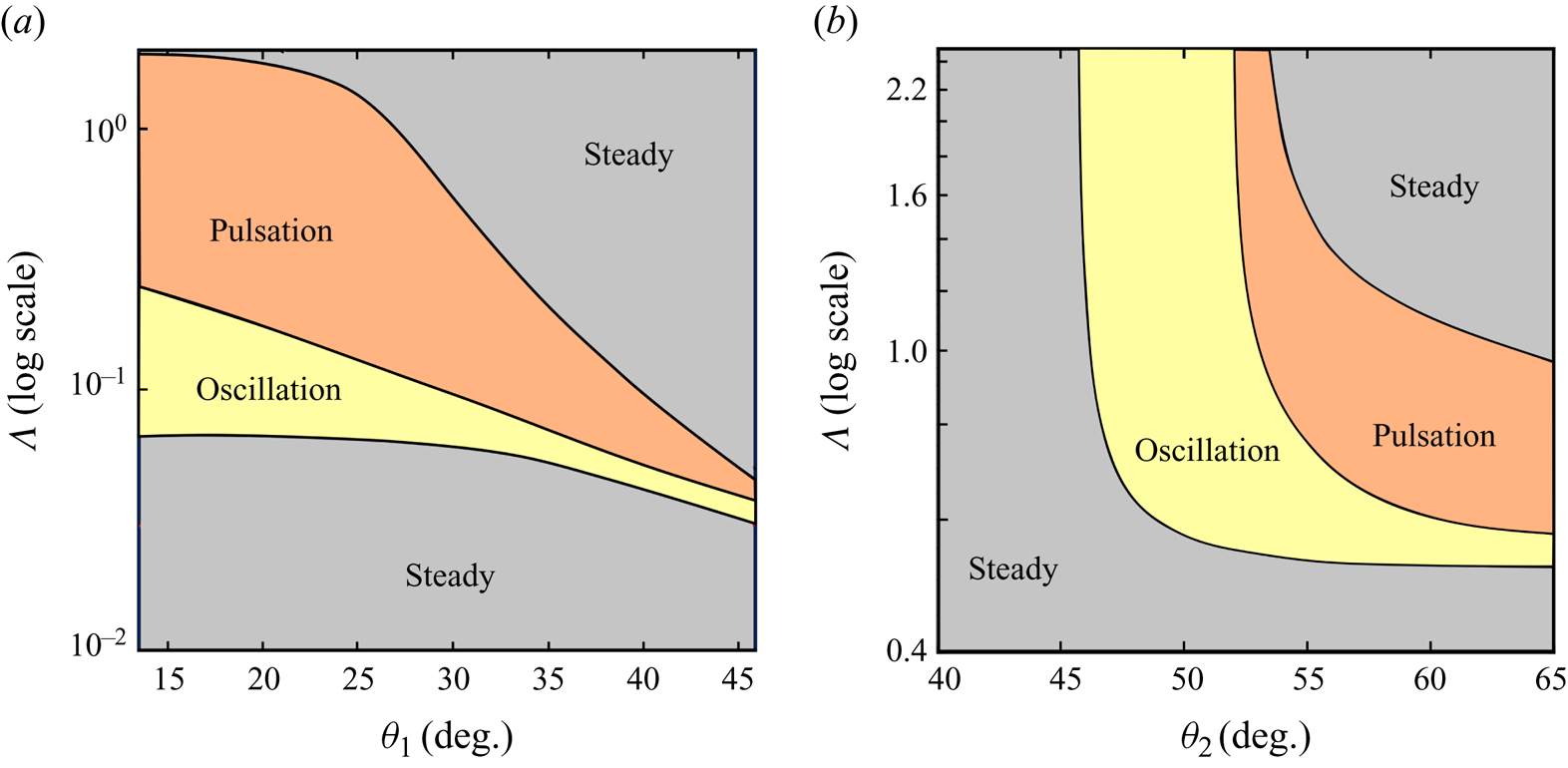
Figure 3. (a) Plot of ![]() $\theta _1$-
$\theta _1$-![]() $\varLambda$ parameter space for a double cone of
$\varLambda$ parameter space for a double cone of ![]() $\theta _2 = 90^\circ$ in a Mach 6 flow, with boundaries between flow states generated empirically from experimental results of Sasidharan & Duvvuri (Reference Sasidharan and Duvvuri2021). (b) Plot of
$\theta _2 = 90^\circ$ in a Mach 6 flow, with boundaries between flow states generated empirically from experimental results of Sasidharan & Duvvuri (Reference Sasidharan and Duvvuri2021). (b) Plot of ![]() $\theta _2$-
$\theta _2$-![]() $\varLambda$ parameter for a double wedge of
$\varLambda$ parameter for a double wedge of ![]() $\theta _1 = 30^\circ$ in a Mach 7 flow, with boundaries between flow states generated empirically from computational results of Kumar & De (Reference Kumar and De2021a).
$\theta _1 = 30^\circ$ in a Mach 7 flow, with boundaries between flow states generated empirically from computational results of Kumar & De (Reference Kumar and De2021a).
The present effort is aimed at obtaining a detailed understanding of the oscillation state of unsteadiness in the high-speed double cone flow. The current understanding of oscillations derived from available literature is qualitative in nature, mostly based on the hypothesis of Kenworthy (Reference Kenworthy1978). Based on an experimental study of the spike-cylinder flow, Kenworthy (Reference Kenworthy1978) concludes that oscillations are sustained through viscous instabilities of the shear layer, and that oscillations originate from an imbalance between two pressure quantities: the so-called ‘reattachment pressure’ generated by the shear layer and the ‘reattachment pressure’ required by geometric constraints. This hypothesis led to an ‘energetic shear-layer’ model (Kenworthy Reference Kenworthy1978) which essentially tries to explain the periodic expansion and contraction of the separation region (which are observed in oscillation-type unsteadiness) based on possible mass exchange near the reattachment point, as illustrated in figure 4. Fluid mass is thought to ‘escape’ from the separation bubble when the ‘bounding streamline’ is above the ‘escape streamline’ (see figure 4a), and fluid mass is thought to be injected into the separation bubble when the ‘bounding streamline’ is below the ‘escape streamline’ (see figure 4b). Feszty et al. (Reference Feszty, Badcock and Richards2004) supports this hypothesis on the basis of a computational study. While the mass exchange mechanism outlined here provides a physical picture of flow oscillations, the insights obtained from the mechanism are not directly amenable to quantitative modelling.

Figure 4. ‘Bounding streamline’ and ‘escape streamline’ shown by Feszty, Badcock & Richards (Reference Feszty, Badcock and Richards2004) for oscillation-type flow unsteadiness over a spike-cylinder model. Here ‘S’ and ‘R’ represent the separation and reattachment points of the shear layer, respectively. This figure is adapted from Feszty et al. (Reference Feszty, Badcock and Richards2004).
The present study of oscillation dynamics in a high-speed double-cone flow takes an aeroacoustic viewpoint. This is partly motivated by broad similarities between double-cone flow oscillations and periodic unsteadiness in canonical open cavity flows (see § 4). The compressible free-shear-layer and the large separated flow region in an open cavity flow exhibit low-frequency unsteadiness (Rossiter Reference Rossiter1964). The specific aims of the present study are twofold:
(i) obtain a quantitative understanding of the dependence of spatiotemporal scales of oscillations on the governing geometric parameters;
(ii) develop a model to predict the Strouhal number (non-dimensional frequency) of flow oscillations.
To achieve these aims, an extensive set of double cone flow experiments were performed at Mach 6. In these experiments ![]() $\theta _1$ and
$\theta _1$ and ![]() $\varLambda$ were varied while
$\varLambda$ were varied while ![]() $\theta _2$ was fixed at
$\theta _2$ was fixed at ![]() $90^\circ$, and the experiments were focused on the oscillation region of the
$90^\circ$, and the experiments were focused on the oscillation region of the ![]() $\theta _1$-
$\theta _1$-![]() $\varLambda$ parameter space. The experimental set-up is briefly described in § 2 and experimental results are presented in § 3. One of the important revelations from these experiments is the presence of two distinct subtypes of oscillations in the double cone flow. Section 3 provides a detailed discussion of the two oscillation subtypes, which are labelled here as ‘free oscillations’ and ‘anchored oscillations’. The aeroacoustic model is described and results from this model are presented in § 4. Finally, a set of brief concluding remarks are presented in § 5.
$\varLambda$ parameter space. The experimental set-up is briefly described in § 2 and experimental results are presented in § 3. One of the important revelations from these experiments is the presence of two distinct subtypes of oscillations in the double cone flow. Section 3 provides a detailed discussion of the two oscillation subtypes, which are labelled here as ‘free oscillations’ and ‘anchored oscillations’. The aeroacoustic model is described and results from this model are presented in § 4. Finally, a set of brief concluding remarks are presented in § 5.
2. Experimental set-up
Experiments were conducted in the Roddam Narasimha Hypersonic Wind Tunnel (RNHWT) at the Indian Institute of Science. RNHWT is a 0.5-m-diameter enclosed free-jet facility (pressure-vacuum type) capable of producing free-stream flow in the Mach number range 6–10 with dry air as the working fluid. A detailed description of RNHWT is given by Thasu & Duvvuri (Reference Thasu and Duvvuri2024). All the experiments for the present study were carried out at free-stream Mach number ![]() $M_\infty = 6$ with stagnation temperature
$M_\infty = 6$ with stagnation temperature ![]() $T_0$ and pressure
$T_0$ and pressure ![]() $P_0$ set to 455 K and 11.1 bar, respectively. The corresponding free-stream unit Reynolds number
$P_0$ set to 455 K and 11.1 bar, respectively. The corresponding free-stream unit Reynolds number ![]() $Re_\infty = 10^7$ m
$Re_\infty = 10^7$ m![]() $^{-1}$, based on density
$^{-1}$, based on density ![]() $\rho _\infty$, speed
$\rho _\infty$, speed ![]() $U_\infty$ and dynamic viscosity
$U_\infty$ and dynamic viscosity ![]() $\mu _\infty$ defined in the free stream. To provide a reference for the flow Reynolds number, it is noted that the slant length of the fore cone (
$\mu _\infty$ defined in the free stream. To provide a reference for the flow Reynolds number, it is noted that the slant length of the fore cone (![]() $l_1$) lies in the range of 44.1 and 78.9 mm for all the double-cone test models used in the present study. All the double-cone models used in the present study have an aft-cone angle
$l_1$) lies in the range of 44.1 and 78.9 mm for all the double-cone test models used in the present study. All the double-cone models used in the present study have an aft-cone angle ![]() $\theta _2 = 90^\circ$, and the test cases are identified by the fore-cone angle
$\theta _2 = 90^\circ$, and the test cases are identified by the fore-cone angle ![]() $\theta _1$ and cone slant length ratio
$\theta _1$ and cone slant length ratio ![]() $\varLambda$. Figure 5(a) shows a representative image of a double-cone model installed in the RNHWT test section. The value of
$\varLambda$. Figure 5(a) shows a representative image of a double-cone model installed in the RNHWT test section. The value of ![]() $\theta _1$ was varied between
$\theta _1$ was varied between ![]() $8^\circ$ and
$8^\circ$ and ![]() $35^\circ$ across experiments, and for any fixed value of
$35^\circ$ across experiments, and for any fixed value of ![]() $\theta _1$, the
$\theta _1$, the ![]() $\varLambda$ values were selected such that an oscillation-type unsteady flow state is realised. The double-cone models were carefully positioned in the test section with zero incidence and side-slip angles for all experiments. Figure 5(b) provides an overview of all the different
$\varLambda$ values were selected such that an oscillation-type unsteady flow state is realised. The double-cone models were carefully positioned in the test section with zero incidence and side-slip angles for all experiments. Figure 5(b) provides an overview of all the different ![]() $\theta _1$–
$\theta _1$–![]() $\varLambda$ combinations for which experimental data were obtained. It is noted that each data marker in figure 5(b) denotes an individual experiment. In addition to data obtained from the present set of experiments, data from the earlier study of Sasidharan & Duvvuri (Reference Sasidharan and Duvvuri2021) are also used here for analysis and modelling (in §§ 3 and 4). Combinations of
$\varLambda$ combinations for which experimental data were obtained. It is noted that each data marker in figure 5(b) denotes an individual experiment. In addition to data obtained from the present set of experiments, data from the earlier study of Sasidharan & Duvvuri (Reference Sasidharan and Duvvuri2021) are also used here for analysis and modelling (in §§ 3 and 4). Combinations of ![]() $\theta _1$-
$\theta _1$-![]() $\varLambda$ for which data are borrowed from Sasidharan & Duvvuri (Reference Sasidharan and Duvvuri2021) are identified in figure 5(b).
$\varLambda$ for which data are borrowed from Sasidharan & Duvvuri (Reference Sasidharan and Duvvuri2021) are identified in figure 5(b).
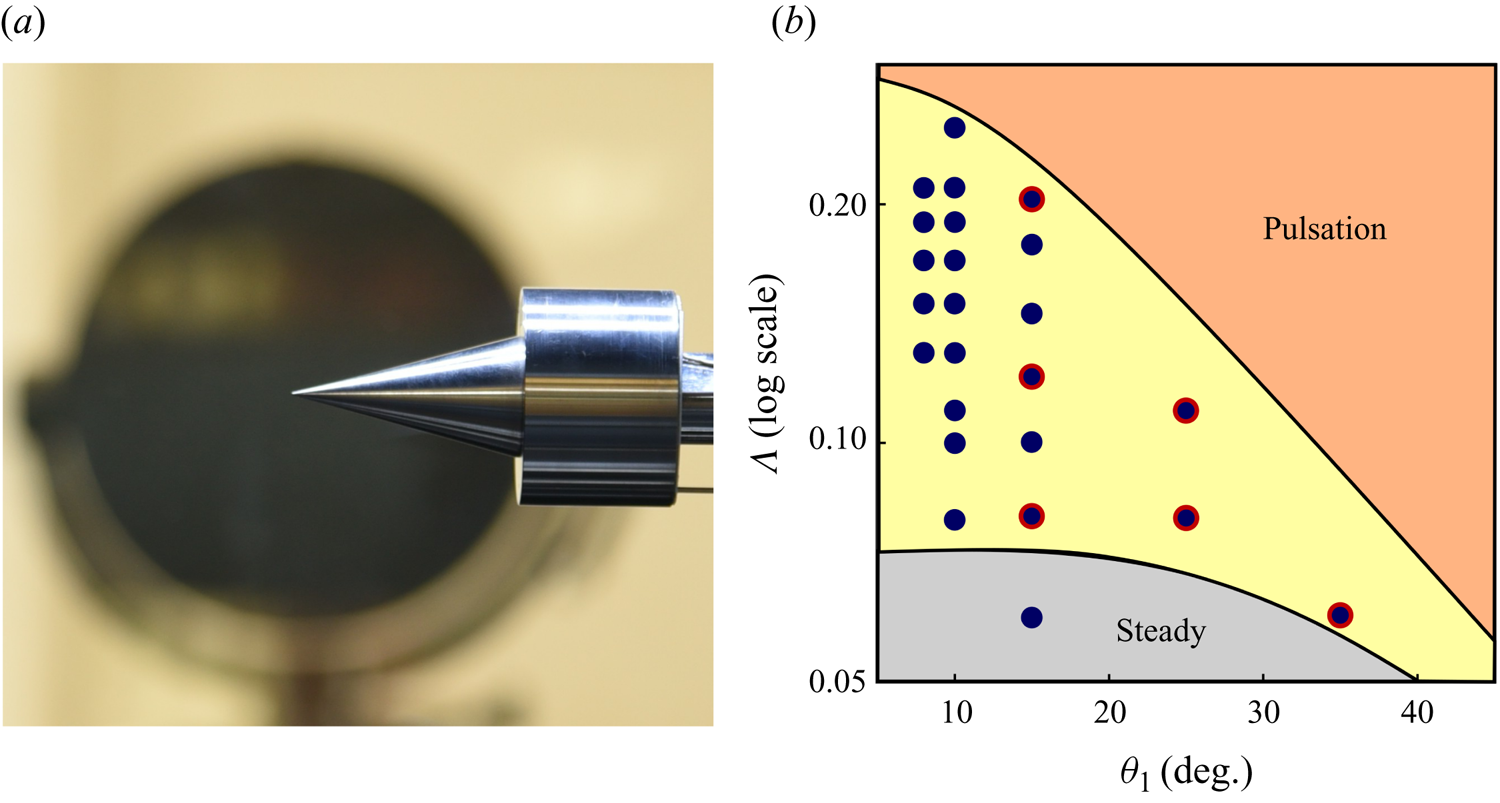
Figure 5. (a) A double cone model installed in the test section of the Roddam Narasimha Hypersonic Wind Tunnel. (b) Data markers (filled circles in dark blue) denote individual experiments; in each experiment data was obtained for a specific combination of ![]() $\theta _1$-
$\theta _1$-![]() $\varLambda$ while
$\varLambda$ while ![]() $\theta _2$ remains fixed at
$\theta _2$ remains fixed at ![]() $90^\circ$ across all experiments. Data markers with a red outline denote experiments performed by Sasidharan & Duvvuri (Reference Sasidharan and Duvvuri2021).
$90^\circ$ across all experiments. Data markers with a red outline denote experiments performed by Sasidharan & Duvvuri (Reference Sasidharan and Duvvuri2021).
In all experiments, unsteady motions in the flow were visualised by employing a high-speed schlieren technique. A high-power pulsed diode laser (Cavilux Smart, 640 nm wavelength, 10 ns pulse width) was used as the light source and a high-speed camera (Phantom V1612) was used for imaging. Schlieren images were recorded at frame rates ranging between 56 000 and 140 000 frames per second. The number of oscillation cycles captured by the schlieren data range between 400 and 1200 across all experiments. These sampling parameters provide a temporal resolution in the range 20–56 images per oscillation cycle. Overall, the data sets obtained in this study contain good spatiotemporal resolution and are sufficiently long (data length) to allow for detailed analysis. Given the symmetry of double cone about the model axis, coverage area of schlieren images was restricted to the top half of the model. It is noted that the schlieren optical settings (knife-edge cut-off level, lens combinations, optical zoom) differ across experiments; the setting for each experiment was optimised to get the best possible schlieren imagery for the particular double-cone model under study. Hence, the same flow density gradient in two different experiments results in different levels of local schlieren light intensity, thereby allowing for only qualitative comparisons of schlieren intensity across different experiments. This aspect, however, does not affect any of the quantitative time scale analysis presented in §§ 3 and 4.
3. Experimental results and analysis
It is instructive to begin the discussion on oscillations by considering the flow structure in a scenario where ![]() $\varLambda \ll 1$, and thereby the flow is nominally steady. Figure 6 shows a representative example of such a flow with
$\varLambda \ll 1$, and thereby the flow is nominally steady. Figure 6 shows a representative example of such a flow with ![]() $[\theta _1,\varLambda ] = [15^\circ,0.06]$. It is noted that this particular combination of
$[\theta _1,\varLambda ] = [15^\circ,0.06]$. It is noted that this particular combination of ![]() $\theta _1$ and
$\theta _1$ and ![]() $\varLambda$ falls in the steady region of the parameter space shown in figure 5(b), and is indicated by a corresponding data marker. From the schlieren image in figure 6, it is clearly seen that an attached conical shock wave at the nose and a strong reattachment shock wave above the cylinder shoulder are formed. This is consistent with expectations since
$\varLambda$ falls in the steady region of the parameter space shown in figure 5(b), and is indicated by a corresponding data marker. From the schlieren image in figure 6, it is clearly seen that an attached conical shock wave at the nose and a strong reattachment shock wave above the cylinder shoulder are formed. This is consistent with expectations since ![]() $\theta _1$ is less than
$\theta _1$ is less than ![]() $\theta _d$, and
$\theta _d$, and ![]() $\theta _2$ is greater than
$\theta _2$ is greater than ![]() $\theta _d$; here
$\theta _d$; here ![]() $\theta _d = 55.5^\circ$ is the conical shock wave detachment angle corresponding to
$\theta _d = 55.5^\circ$ is the conical shock wave detachment angle corresponding to ![]() $M_{\infty } = 6$. Flow turning by the aft cone results in boundary layer flow separation over the fore-cone surface and generation of a separation shock wave. The intersection of separation and conical shock waves give rise to the intermediate shock wave, which then interacts with the reattachment shock wave at a downstream location. A compressible shear layer forms over the separated flow region, and it reattaches at the aft-cone (cylinder) shoulder. The shear layer is a region of large density gradient in the cross-stream direction and, hence, it is easily identified in the schlieren image. All these flow features are illustrated schematically in figure 7. Point
$M_{\infty } = 6$. Flow turning by the aft cone results in boundary layer flow separation over the fore-cone surface and generation of a separation shock wave. The intersection of separation and conical shock waves give rise to the intermediate shock wave, which then interacts with the reattachment shock wave at a downstream location. A compressible shear layer forms over the separated flow region, and it reattaches at the aft-cone (cylinder) shoulder. The shear layer is a region of large density gradient in the cross-stream direction and, hence, it is easily identified in the schlieren image. All these flow features are illustrated schematically in figure 7. Point ![]() $S$ in the figure marks the separation point, and
$S$ in the figure marks the separation point, and ![]() $L_s$ and
$L_s$ and ![]() $\theta _s$ represent the length of the shear layer and the shear layer angle with the cone surface, respectively. The markings ‘
$\theta _s$ represent the length of the shear layer and the shear layer angle with the cone surface, respectively. The markings ‘![]() $i$’ and ‘
$i$’ and ‘![]() $o$’ in the figure denote the flow regions inside and outside of the separation bubble, and they are used as subscripts to identify physical quantities in corresponding regions of the flow. It is noted that the flow for this geometric configuration is taken to be nominally steady, notwithstanding some non-periodic jitters of very small amplitude arising from incipient instabilities of the shear layer.
$o$’ in the figure denote the flow regions inside and outside of the separation bubble, and they are used as subscripts to identify physical quantities in corresponding regions of the flow. It is noted that the flow for this geometric configuration is taken to be nominally steady, notwithstanding some non-periodic jitters of very small amplitude arising from incipient instabilities of the shear layer.
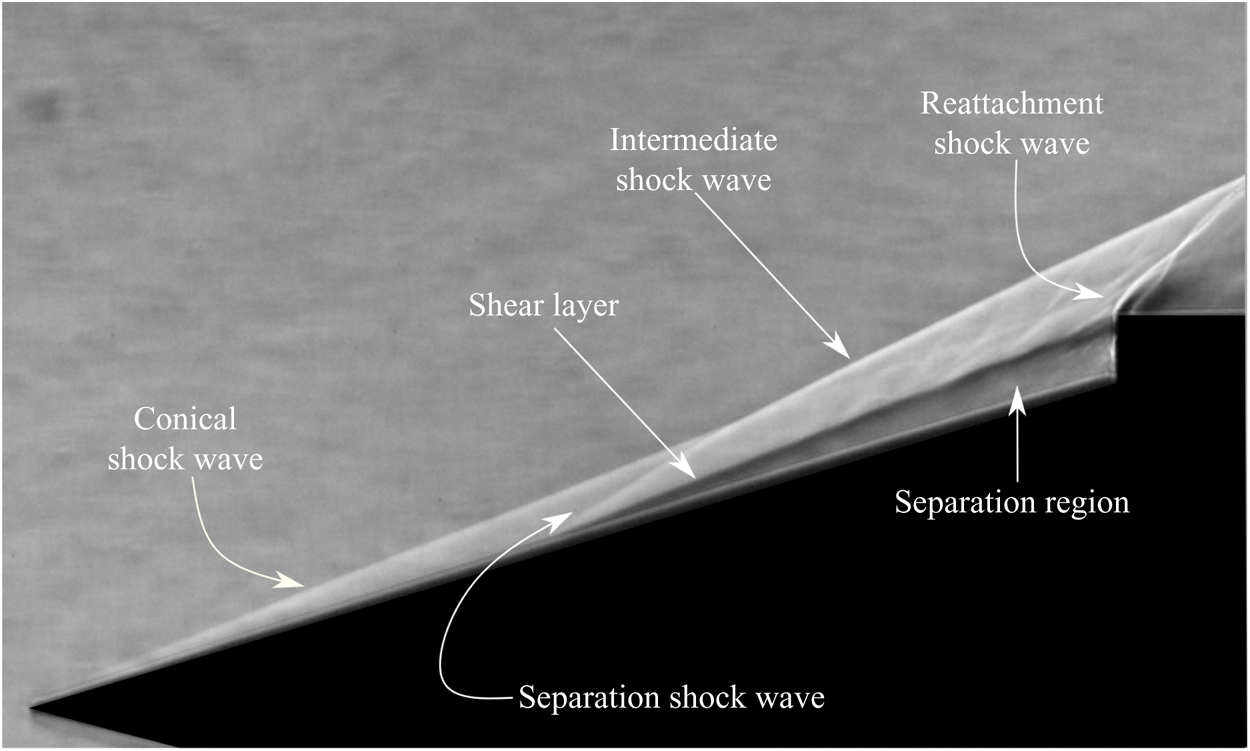
Figure 6. An instantaneous schlieren snapshot of the flow for ![]() $[\theta _1,\varLambda ] = [15^\circ,0.06]$. Due to the relatively small value of
$[\theta _1,\varLambda ] = [15^\circ,0.06]$. Due to the relatively small value of ![]() $\varLambda$, this flow is nominally steady (see the movie in the supplementary material available at https://doi.org/10.1017/jfm.2024.449).
$\varLambda$, this flow is nominally steady (see the movie in the supplementary material available at https://doi.org/10.1017/jfm.2024.449).
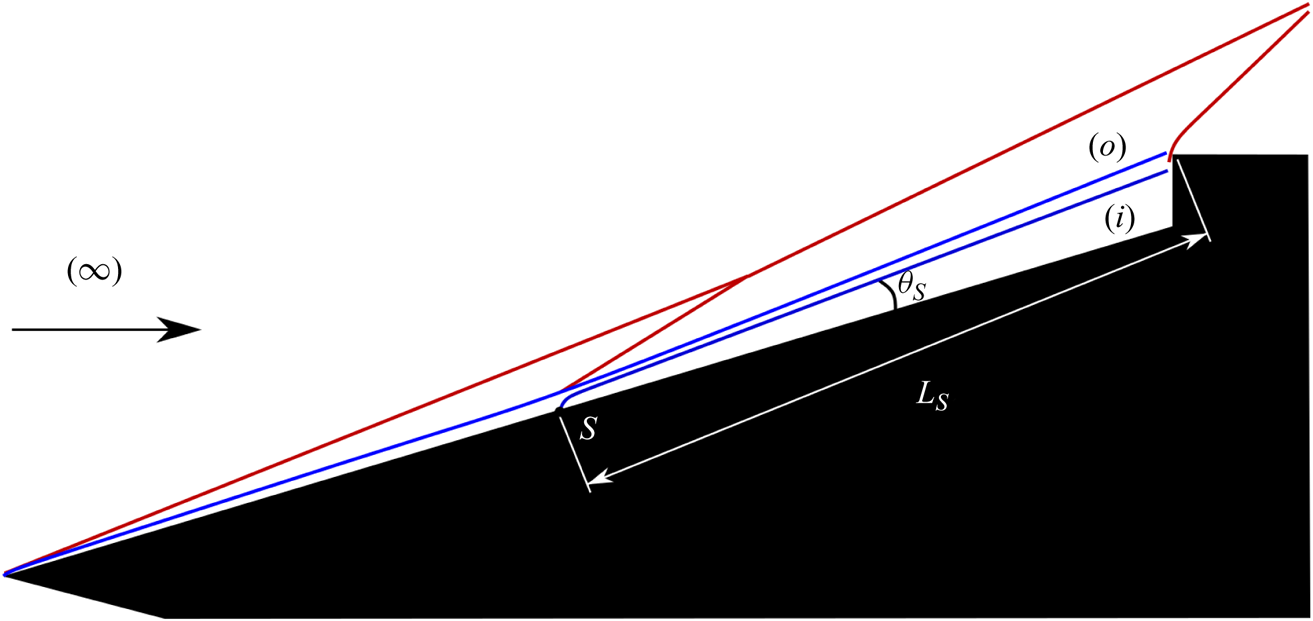
Figure 7. A schematic representation of the flow shown in figure 6. Shock waves are represented in red and shear layer in blue. Here ![]() $(\infty )$ represents the incoming free-stream flow. Location
$(\infty )$ represents the incoming free-stream flow. Location ![]() $S$ marks the separation point, and flow regions inside and outside separation bubble are marked by (
$S$ marks the separation point, and flow regions inside and outside separation bubble are marked by (![]() $i$) and (
$i$) and (![]() $o$). The length of the shear layer, measured along the shear layer between the separation and the reattachment points, is denoted by
$o$). The length of the shear layer, measured along the shear layer between the separation and the reattachment points, is denoted by ![]() $L_s$. The angle formed by the shear layer with the fore-cone surface is denoted by
$L_s$. The angle formed by the shear layer with the fore-cone surface is denoted by ![]() $\theta _s$.
$\theta _s$.
For a given ![]() $\theta _1$ and
$\theta _1$ and ![]() $l_1$, the separation region size scales with
$l_1$, the separation region size scales with ![]() $l_2$ and, hence, the shear layer length
$l_2$ and, hence, the shear layer length ![]() $L_s$ increases as
$L_s$ increases as ![]() $\varLambda$ is increased. For small values of
$\varLambda$ is increased. For small values of ![]() $\varLambda$,
$\varLambda$, ![]() $L_s$ is sufficiently short for the shear layer to remain steady, as seen in the example shown in figure 6. However, beyond a certain critical value of
$L_s$ is sufficiently short for the shear layer to remain steady, as seen in the example shown in figure 6. However, beyond a certain critical value of ![]() $\varLambda$, the shear layer has a sufficiently long development length for instabilities to manifest, pushing the entire flow into the oscillations regime of unsteadiness. During oscillations, unsteady flow structures in the shear layer induce small-amplitude high-frequency undulations in the intermediate shock wave structure. The separation region also experiences small-amplitude expansions and contractions in size due to impingement of the unsteady shear layer on the aft-cone surface. For intermediate values of
$\varLambda$, the shear layer has a sufficiently long development length for instabilities to manifest, pushing the entire flow into the oscillations regime of unsteadiness. During oscillations, unsteady flow structures in the shear layer induce small-amplitude high-frequency undulations in the intermediate shock wave structure. The separation region also experiences small-amplitude expansions and contractions in size due to impingement of the unsteady shear layer on the aft-cone surface. For intermediate values of ![]() $\varLambda$ the separation point
$\varLambda$ the separation point ![]() $S$ also exhibits periodic fore-and-aft motion along the cone surface (see § 3.1). The dynamics of all these unsteady motions are coupled, and collectively the motions are termed as oscillations. The rest of this paper describes these oscillations in detail.
$S$ also exhibits periodic fore-and-aft motion along the cone surface (see § 3.1). The dynamics of all these unsteady motions are coupled, and collectively the motions are termed as oscillations. The rest of this paper describes these oscillations in detail.
3.1. Effect of cone slant length ratio  $\varLambda$: free and anchored oscillations
$\varLambda$: free and anchored oscillations
The effect of cone slant length ratio on the nature of oscillations is discussed here. As a representative example, figure 8 shows schlieren data for six different values of ![]() $\varLambda$ in the range 0.08 and 0.2 with fixed
$\varLambda$ in the range 0.08 and 0.2 with fixed ![]() $\theta _1 = 15^\circ$. The influence of
$\theta _1 = 15^\circ$. The influence of ![]() $\varLambda$ on flow behaviour at other values of
$\varLambda$ on flow behaviour at other values of ![]() $\theta _1$ are qualitatively similar. The standard deviation maps of schlieren light intensity shown in the figure are generated from high-speed schlieren data, and serve as a direct indicator of local flow unsteadiness levels. It is noted that schlieren light intensity is a measure of the density gradient (Liepmann & Roshko Reference Liepmann and Roshko1957). The growth in size of the separated flow region with increasing
$\theta _1$ are qualitatively similar. The standard deviation maps of schlieren light intensity shown in the figure are generated from high-speed schlieren data, and serve as a direct indicator of local flow unsteadiness levels. It is noted that schlieren light intensity is a measure of the density gradient (Liepmann & Roshko Reference Liepmann and Roshko1957). The growth in size of the separated flow region with increasing ![]() $\varLambda$ can be inferred from a visual comparison of the schlieren snapshots in the figure. A comparison of figures 6 and 8(a) shows that as
$\varLambda$ can be inferred from a visual comparison of the schlieren snapshots in the figure. A comparison of figures 6 and 8(a) shows that as ![]() $\varLambda$ is increased from 0.06 to 0.08, there is a significant increase in the size of the separation region, and the downstream portion of the shear layer clearly becomes unsteady. From
$\varLambda$ is increased from 0.06 to 0.08, there is a significant increase in the size of the separation region, and the downstream portion of the shear layer clearly becomes unsteady. From ![]() $\varLambda = 0.08$ to 0.12, figure 8(a–c), the size of the separation bubble increases in the lateral direction. An interesting aspect of flow oscillations for
$\varLambda = 0.08$ to 0.12, figure 8(a–c), the size of the separation bubble increases in the lateral direction. An interesting aspect of flow oscillations for ![]() $\varLambda = 0.08$, 0.10 and 0.12 is the periodic fore-and-aft motion of the separation point
$\varLambda = 0.08$, 0.10 and 0.12 is the periodic fore-and-aft motion of the separation point ![]() $S$ along the fore-cone surface, and the accompanying motion of the separation shock wave. This aspect is highlighted in the left column of figure 9 where two snapshots from a single oscillation period with an approximate phase difference of
$S$ along the fore-cone surface, and the accompanying motion of the separation shock wave. This aspect is highlighted in the left column of figure 9 where two snapshots from a single oscillation period with an approximate phase difference of ![]() $180^\circ$ are shown for
$180^\circ$ are shown for ![]() $\varLambda = 0.08$. From a comparison of figure 9(a,b) it is readily seen that the separation point
$\varLambda = 0.08$. From a comparison of figure 9(a,b) it is readily seen that the separation point ![]() $S$ translates along the cone surface, and the shear layer transition/breakdown point
$S$ translates along the cone surface, and the shear layer transition/breakdown point ![]() $T'$ also translates along with
$T'$ also translates along with ![]() $S$ by approximately the same distance. The point
$S$ by approximately the same distance. The point ![]() $T'$ is visually identified in the schlieren images by the clear breakdown in the laminar shear layer structure. This type of flow oscillation, characterised by the periodic motion of the separation point, is labelled here as ‘free oscillation’. It is noted that the excursion length of
$T'$ is visually identified in the schlieren images by the clear breakdown in the laminar shear layer structure. This type of flow oscillation, characterised by the periodic motion of the separation point, is labelled here as ‘free oscillation’. It is noted that the excursion length of ![]() $S$ was found to be in the range 3 % to 5 % of
$S$ was found to be in the range 3 % to 5 % of ![]() $l_1$ across all the free-oscillation cases that were observed in the present set of experiments.
$l_1$ across all the free-oscillation cases that were observed in the present set of experiments.

Figure 8. Instantaneous schlieren snapshots (top halves in grey scale) and normalised standard deviation of temporal fluctuations in schlieren image light intensity calculated from high-speed schlieren data (bottom halves) for different values of ![]() $\varLambda$ at fixed
$\varLambda$ at fixed ![]() $\theta _1 = 15^\circ$. Blue and red colours represent low and high intensity of temporal fluctuations, respectively. Going from (a) to (c), it is seen that shear layer breakdown leads to increased thickness of the shear layer and higher levels of fluctuations. Lateral movement of the shear layer in anchored-oscillation cases (e) and ( f) leads to a merger of the two regions that show large fluctuations, i.e. the areas around the separation shock wave and the shear layer.
$\theta _1 = 15^\circ$. Blue and red colours represent low and high intensity of temporal fluctuations, respectively. Going from (a) to (c), it is seen that shear layer breakdown leads to increased thickness of the shear layer and higher levels of fluctuations. Lateral movement of the shear layer in anchored-oscillation cases (e) and ( f) leads to a merger of the two regions that show large fluctuations, i.e. the areas around the separation shock wave and the shear layer.
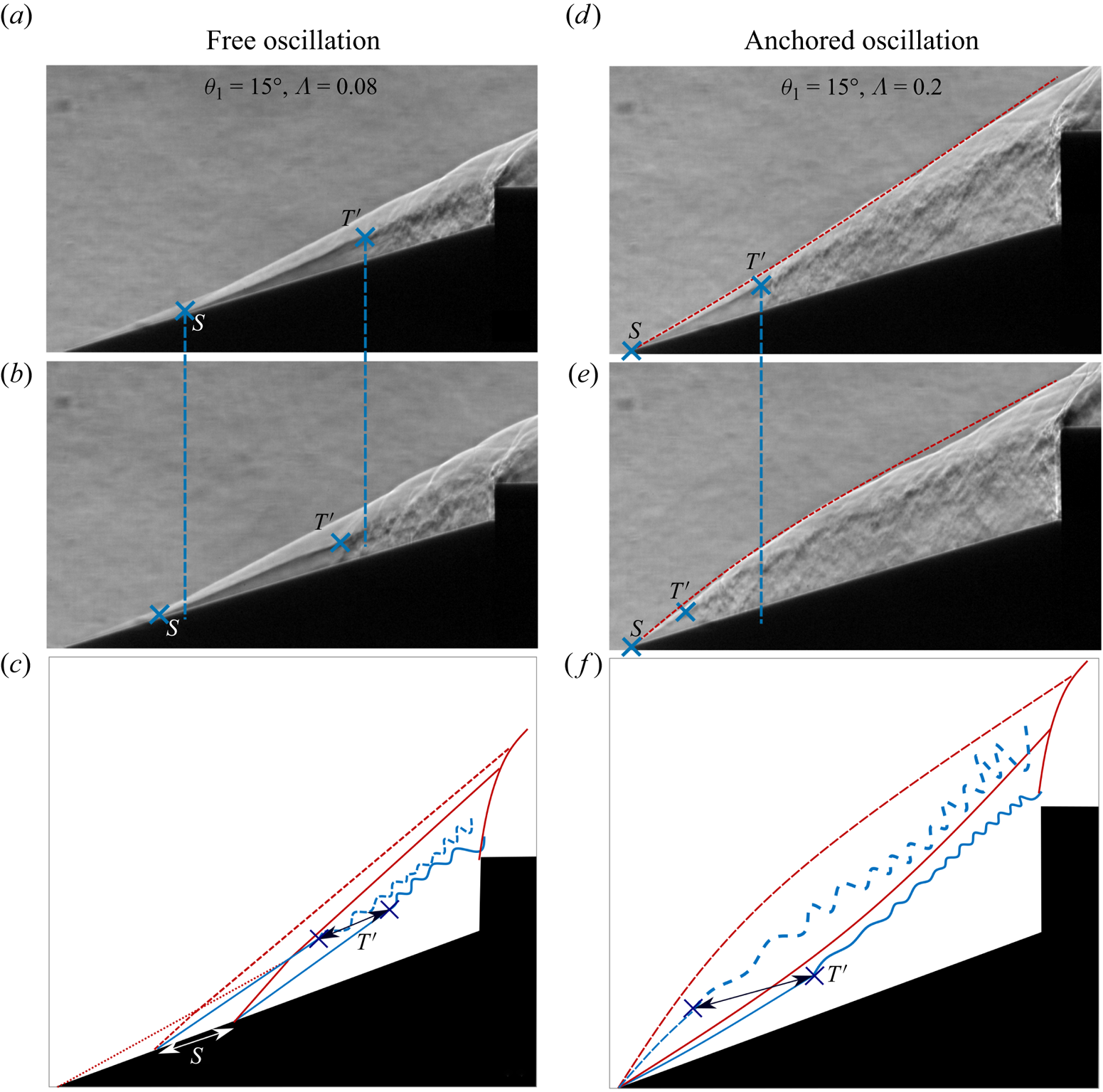
Figure 9. A comparison of flow features between free and anchored oscillations. The schlieren snapshots (a) and (b) are from a single cycle of free oscillation, separated by approximately 180![]() $^\circ$ in phase. Similarly, the schlieren snapshots (d) and (e) are from a single cycle of anchored oscillation, separated by approximately 180
$^\circ$ in phase. Similarly, the schlieren snapshots (d) and (e) are from a single cycle of anchored oscillation, separated by approximately 180![]() $^\circ$ in phase. Here
$^\circ$ in phase. Here ![]() $T'$ marks the location where the shear layer breaks down due to rapid growth of instabilities. The schematics (c) and (f) illustrate the motion of the separation shock wave and the shear layer in free and anchored oscillations, respectively. The movie provided in the supplementary material also helps in making a comparison between free and anchored oscillations.
$T'$ marks the location where the shear layer breaks down due to rapid growth of instabilities. The schematics (c) and (f) illustrate the motion of the separation shock wave and the shear layer in free and anchored oscillations, respectively. The movie provided in the supplementary material also helps in making a comparison between free and anchored oscillations.
As the size of the separation region grows with increasing ![]() $\varLambda$, the separation point ultimately reaches the cone nose for a sufficiently large
$\varLambda$, the separation point ultimately reaches the cone nose for a sufficiently large ![]() $\varLambda$ and remains anchored in that location even as
$\varLambda$ and remains anchored in that location even as ![]() $\varLambda$ is further increased. In this regime of flow oscillations, where the separation point is anchored at the nose, the separation shock wave exhibits clear motion in the transverse direction due to periodic volume expansions (bulging) and contractions of the separation region. These motions, which are distinct from those observed in free oscillations, can be understood in terms of the motion constraint on the separation point driving the separation region to expand in the transverse direction. This type of flow oscillation, characterised by the separation point remaining fixed at the cone nose, is labelled here as ‘anchored oscillation’. The right column of figure 9 shows a representative example of the same, where two snapshots from a single oscillation period with an approximate phase difference of
$\varLambda$ is further increased. In this regime of flow oscillations, where the separation point is anchored at the nose, the separation shock wave exhibits clear motion in the transverse direction due to periodic volume expansions (bulging) and contractions of the separation region. These motions, which are distinct from those observed in free oscillations, can be understood in terms of the motion constraint on the separation point driving the separation region to expand in the transverse direction. This type of flow oscillation, characterised by the separation point remaining fixed at the cone nose, is labelled here as ‘anchored oscillation’. The right column of figure 9 shows a representative example of the same, where two snapshots from a single oscillation period with an approximate phase difference of ![]() $180^\circ$ are shown for
$180^\circ$ are shown for ![]() $\varLambda = 0.2$. From a comparison of figure 9(d,e) it is readily seen that the separation point
$\varLambda = 0.2$. From a comparison of figure 9(d,e) it is readily seen that the separation point ![]() $S$ remains anchored at cone nose, but interestingly,
$S$ remains anchored at cone nose, but interestingly, ![]() $T'$ shows a large excursion. This aspect of anchored oscillations is discussed next.
$T'$ shows a large excursion. This aspect of anchored oscillations is discussed next.
In addition to the apparent geometrical differences in motions between free and anchored oscillations, an important distinction is seen in the instantaneous length of the shear layer between points ![]() $S$ and
$S$ and ![]() $T'$. It is noted that this length is simply the development length required by the shear layer to transition from a steady, laminar, state to an unsteady state under the given flow conditions. In free oscillations, as
$T'$. It is noted that this length is simply the development length required by the shear layer to transition from a steady, laminar, state to an unsteady state under the given flow conditions. In free oscillations, as ![]() $S$ translates along the cone surface,
$S$ translates along the cone surface, ![]() $T'$ follows the translations of
$T'$ follows the translations of ![]() $S$ such that the shear layer length between points
$S$ such that the shear layer length between points ![]() $S$ and
$S$ and ![]() $T'$ remains approximately constant. This however is not the case in anchored oscillations, as evidenced by the example shown in figure 9(d,e). The large excursions of
$T'$ remains approximately constant. This however is not the case in anchored oscillations, as evidenced by the example shown in figure 9(d,e). The large excursions of ![]() $T'$, which appears to be periodic from visual inspection, can be explained using the stability properties of a compressible shear layer. For compressible shear layers (Brown & Roshko Reference Brown and Roshko1974; Papamoschou & Roshko Reference Papamoschou and Roshko1988), it is known that the growth rate of instabilities in the shear layer region is dependent on Mach numbers on either sides of the layer (
$T'$, which appears to be periodic from visual inspection, can be explained using the stability properties of a compressible shear layer. For compressible shear layers (Brown & Roshko Reference Brown and Roshko1974; Papamoschou & Roshko Reference Papamoschou and Roshko1988), it is known that the growth rate of instabilities in the shear layer region is dependent on Mach numbers on either sides of the layer (![]() $M_o$ and
$M_o$ and ![]() $M_i$), Reynolds number (
$M_i$), Reynolds number (![]() $Re = \rho _ou_oL/\mu _o$), density ratio (
$Re = \rho _ou_oL/\mu _o$), density ratio (![]() $\rho _o/\rho _i$) and the length of the shear layer to momentum thickness of the shear layer at the separation point (
$\rho _o/\rho _i$) and the length of the shear layer to momentum thickness of the shear layer at the separation point (![]() $L/\theta$). That is,
$L/\theta$). That is,
where ![]() $f$ denotes the functional dependence, and subscripts
$f$ denotes the functional dependence, and subscripts ![]() $o$ and
$o$ and ![]() $i$ refer to the locations outside (above the shear layer) and inside (below the shear layer) the separation bubble, respectively (as shown in figure 7). Since in the present case the Mach number on the low-speed side (
$i$ refer to the locations outside (above the shear layer) and inside (below the shear layer) the separation bubble, respectively (as shown in figure 7). Since in the present case the Mach number on the low-speed side (![]() $M_i$) is very small due to recirculating subsonic flow inside the separation bubble, the flow properties on the low-speed side can approximately be considered to be equal to the average local stagnation conditions. With that we have
$M_i$) is very small due to recirculating subsonic flow inside the separation bubble, the flow properties on the low-speed side can approximately be considered to be equal to the average local stagnation conditions. With that we have
where ![]() $g$ is obtained from basic isentropic flow relations. These simplifications lead to the conclusion that for a fixed stagnation flow conditions
$g$ is obtained from basic isentropic flow relations. These simplifications lead to the conclusion that for a fixed stagnation flow conditions ![]() $P_i$,
$P_i$, ![]() $T_i$ and
$T_i$ and ![]() $\gamma$ (which are constant in the wind tunnel experiments), the growth rate only depends on the local Mach number (
$\gamma$ (which are constant in the wind tunnel experiments), the growth rate only depends on the local Mach number (![]() $M_o$) on the high-speed side of the shear layer and the ratio of the shear layer length to momentum thickness (
$M_o$) on the high-speed side of the shear layer and the ratio of the shear layer length to momentum thickness (![]() $L/\theta$).
$L/\theta$).
Now, for free-oscillation cases where the separation point freely moves along the cone surface, it is observed that the separation shock wave angle and the shear-layer angle ![]() $\theta _s$ remain nominally constant throughout the oscillation cycle. This leads to a constant Mach number on the high-speed side of the shear layer and, hence, a constant shear layer transition length as per the above arguments. The motions of the separated flow system in a free-oscillation cycle are schematically illustrated in figure 9(c). In case of anchored oscillations, the shear layer transition location
$\theta _s$ remain nominally constant throughout the oscillation cycle. This leads to a constant Mach number on the high-speed side of the shear layer and, hence, a constant shear layer transition length as per the above arguments. The motions of the separated flow system in a free-oscillation cycle are schematically illustrated in figure 9(c). In case of anchored oscillations, the shear layer transition location ![]() $T'$ experiences periodic motion even though the separation point
$T'$ experiences periodic motion even though the separation point ![]() $S$ remains anchored. The motion of
$S$ remains anchored. The motion of ![]() $T'$ can be explained by the fact that the Mach number on the high-speed side of the shear layer is varying in a periodic manner. This variation is brought about by the periodic change in the local separation shock wave angle at the cone nose due to the biconvex arching motion exhibited by the separation shock wave during the anchored-oscillation cycle. This biconvex arching can be seen clearly in figure 9(d,e), and is illustrated schematically in figure 9(f). From basic shock wave relations we know that higher the shock wave angle, the lower the downstream Mach number. Hence, we expect the Mach number above the shear layer (
$T'$ can be explained by the fact that the Mach number on the high-speed side of the shear layer is varying in a periodic manner. This variation is brought about by the periodic change in the local separation shock wave angle at the cone nose due to the biconvex arching motion exhibited by the separation shock wave during the anchored-oscillation cycle. This biconvex arching can be seen clearly in figure 9(d,e), and is illustrated schematically in figure 9(f). From basic shock wave relations we know that higher the shock wave angle, the lower the downstream Mach number. Hence, we expect the Mach number above the shear layer (![]() $M_o$) to be the smallest at the time instant when the separation shock wave has the maximum outward bulge (largest shock wave angle locally at the nose), and the Mach number to be the largest at the time instant when the separation shock wave has the maximum inward depression (smallest shock wave angle locally at the nose). In general, the stability of compressible shear layers increases with Mach number, i.e. at a higher Mach number, instabilities in the shear layer manifest at higher values of local flow Reynolds number, needing a longer development length for shear layer breakdown (Papamoschou & Roshko Reference Papamoschou and Roshko1988). Hence, we expect the shear layer to have a longer development length for transition at the time instant when the separation shock wave is depressed inward as compared to the time instant when the shock wave is bulging outward. The experimental observations in figure 9(d,e) are very much consistent with this expectation.
$M_o$) to be the smallest at the time instant when the separation shock wave has the maximum outward bulge (largest shock wave angle locally at the nose), and the Mach number to be the largest at the time instant when the separation shock wave has the maximum inward depression (smallest shock wave angle locally at the nose). In general, the stability of compressible shear layers increases with Mach number, i.e. at a higher Mach number, instabilities in the shear layer manifest at higher values of local flow Reynolds number, needing a longer development length for shear layer breakdown (Papamoschou & Roshko Reference Papamoschou and Roshko1988). Hence, we expect the shear layer to have a longer development length for transition at the time instant when the separation shock wave is depressed inward as compared to the time instant when the shock wave is bulging outward. The experimental observations in figure 9(d,e) are very much consistent with this expectation.
Among the oscillations cases shown in figure 8, ![]() $\varLambda = 0.15$ falls at the cusp, between free- and anchored-oscillation states of unsteadiness. For
$\varLambda = 0.15$ falls at the cusp, between free- and anchored-oscillation states of unsteadiness. For ![]() $\varLambda = 0.15$ the separation point
$\varLambda = 0.15$ the separation point ![]() $S$ is seen to be anchored to the cone nose for a part of the oscillation cycle period, and for the rest of the period
$S$ is seen to be anchored to the cone nose for a part of the oscillation cycle period, and for the rest of the period ![]() $S$ exhibits a small excursion from the nose. We refer to these boundary cases as mixed oscillations, since they contain features of both free- and anchored-oscillation states. For
$S$ exhibits a small excursion from the nose. We refer to these boundary cases as mixed oscillations, since they contain features of both free- and anchored-oscillation states. For ![]() $\varLambda = 0.18$ and 0.20, however, the flow completely transitions to a state where the separation point is fully anchored to the cone nose for entire oscillation cycle and shows shear layer and shock wave movement as discussed previously. In summary, for a fixed
$\varLambda = 0.18$ and 0.20, however, the flow completely transitions to a state where the separation point is fully anchored to the cone nose for entire oscillation cycle and shows shear layer and shock wave movement as discussed previously. In summary, for a fixed ![]() $\theta _1$ and starting at a small value of
$\theta _1$ and starting at a small value of ![]() $\varLambda$ where the flow is steady with a small separation bubble, an increase in
$\varLambda$ where the flow is steady with a small separation bubble, an increase in ![]() $\varLambda$ transitions the flow to a state of free oscillations, and subsequently to a state of anchored oscillations. On further increasing
$\varLambda$ transitions the flow to a state of free oscillations, and subsequently to a state of anchored oscillations. On further increasing ![]() $\varLambda$, the flow transitions to a pulsation state, which is fundamentally very different from oscillations, and is not of present concern.
$\varLambda$, the flow transitions to a pulsation state, which is fundamentally very different from oscillations, and is not of present concern.
3.2. Effect of fore-cone angle ( $\theta _1$)
$\theta _1$)
To illustrate the effects of fore-cone angle (![]() $\theta _1$) on the flow, cases with
$\theta _1$) on the flow, cases with ![]() $\theta _1 = 15^\circ$,
$\theta _1 = 15^\circ$, ![]() $25^\circ$ and
$25^\circ$ and ![]() $35^\circ$ are discussed briefly here as representative examples. Figure 10 shows schlieren data for the three different angles. A visual comparison across the subfigures in figure 10 shows that an increase in
$35^\circ$ are discussed briefly here as representative examples. Figure 10 shows schlieren data for the three different angles. A visual comparison across the subfigures in figure 10 shows that an increase in ![]() $\theta _1$, with approximately the same
$\theta _1$, with approximately the same ![]() $\varLambda$, brings about a reduction in the size of the separation region. It is noted that the flow turn angle (
$\varLambda$, brings about a reduction in the size of the separation region. It is noted that the flow turn angle (![]() $90^\circ$-
$90^\circ$-![]() $\theta _1$) at the vertex between the two cones decreases with increasing
$\theta _1$) at the vertex between the two cones decreases with increasing ![]() $\theta _1$, and it is expected that a lower turn angle results in a smaller separation region since pressure gradients generated near the wall by the turning flow will be less adverse.
$\theta _1$, and it is expected that a lower turn angle results in a smaller separation region since pressure gradients generated near the wall by the turning flow will be less adverse.
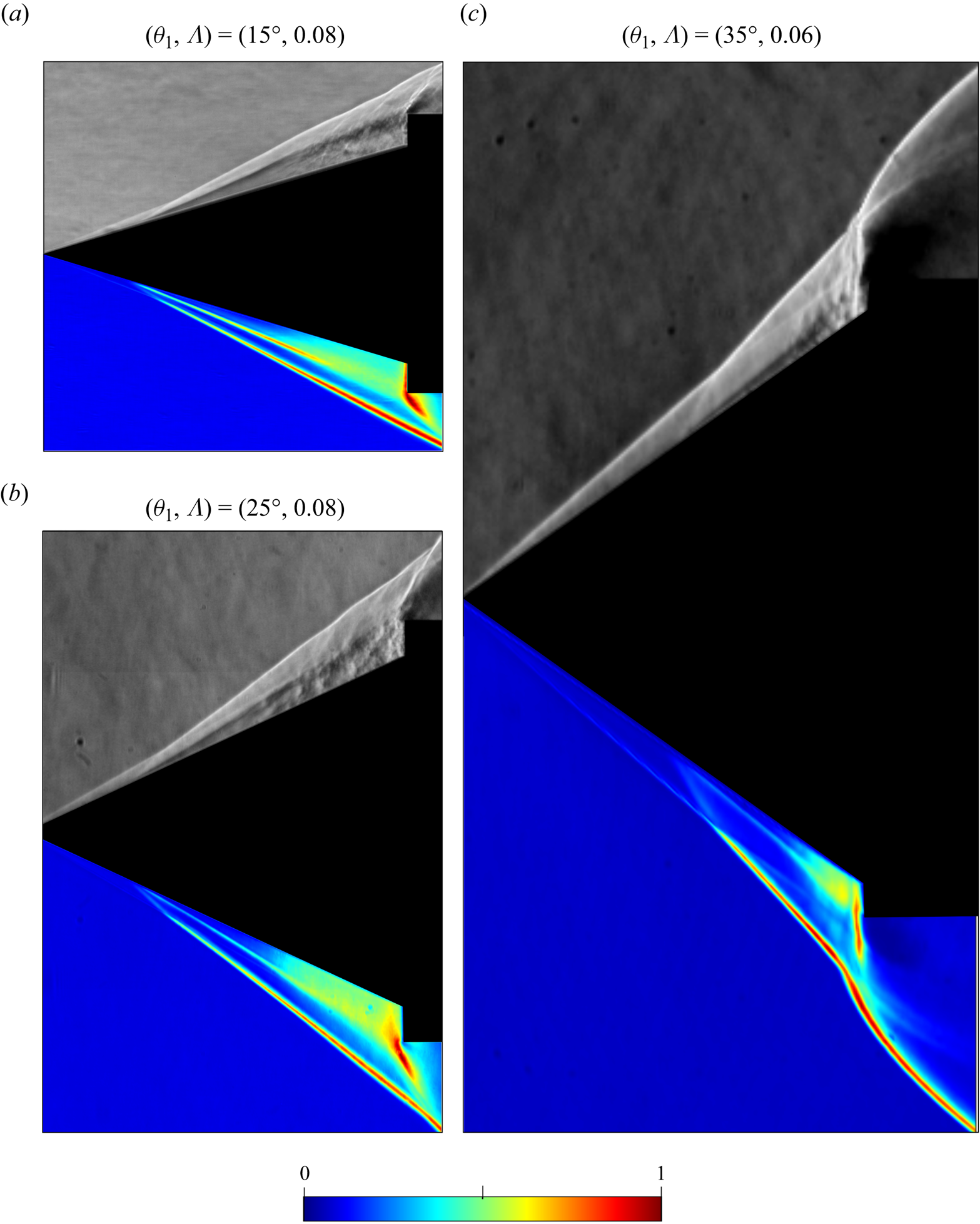
Figure 10. Instantaneous schlieren snapshots (top halves of subfigures) and standard deviation maps of schlieren light intensity (bottom halves of subfigures).
Another effect of increasing ![]() $\theta _1$ is the increase in the conical shock wave angle, and the resulting decrease in the Mach number downstream of the conical shock wave and above the shear layer (
$\theta _1$ is the increase in the conical shock wave angle, and the resulting decrease in the Mach number downstream of the conical shock wave and above the shear layer (![]() $M_o$). As discussed above, a decrease in
$M_o$). As discussed above, a decrease in ![]() $M_o$ leads to shear layer breakdown at a relatively upstream location, i.e. a shorter development length is needed for shear layer transition. This effect is seen when figure 10(a,b) are compared, where
$M_o$ leads to shear layer breakdown at a relatively upstream location, i.e. a shorter development length is needed for shear layer transition. This effect is seen when figure 10(a,b) are compared, where ![]() $\varLambda = 0.08$ in both cases, and also in comparison with figure 10(c) where
$\varLambda = 0.08$ in both cases, and also in comparison with figure 10(c) where ![]() $\varLambda$ is nearly the same.
$\varLambda$ is nearly the same.
3.3. Strouhal number scaling
The ![]() $\theta _1$-
$\theta _1$-![]() $\varLambda$ parameter space shown in figure 5(b) is shown again in figure 11, but here the experimental data markers are classified as per the oscillation types discussed in § 3.1, i.e. free oscillations, anchored oscillations and mixed oscillations that show features of both free and anchored oscillations. From the figure, it is noted that only free oscillations were observed for
$\varLambda$ parameter space shown in figure 5(b) is shown again in figure 11, but here the experimental data markers are classified as per the oscillation types discussed in § 3.1, i.e. free oscillations, anchored oscillations and mixed oscillations that show features of both free and anchored oscillations. From the figure, it is noted that only free oscillations were observed for ![]() $\theta _1 = 25^\circ$ and
$\theta _1 = 25^\circ$ and ![]() $35^\circ$ at the
$35^\circ$ at the ![]() $\varLambda$ values chosen for this study, whereas for
$\varLambda$ values chosen for this study, whereas for ![]() $\theta _1 \leq 15^\circ$ both subtypes of oscillations, free and anchored, were observed.
$\theta _1 \leq 15^\circ$ both subtypes of oscillations, free and anchored, were observed.
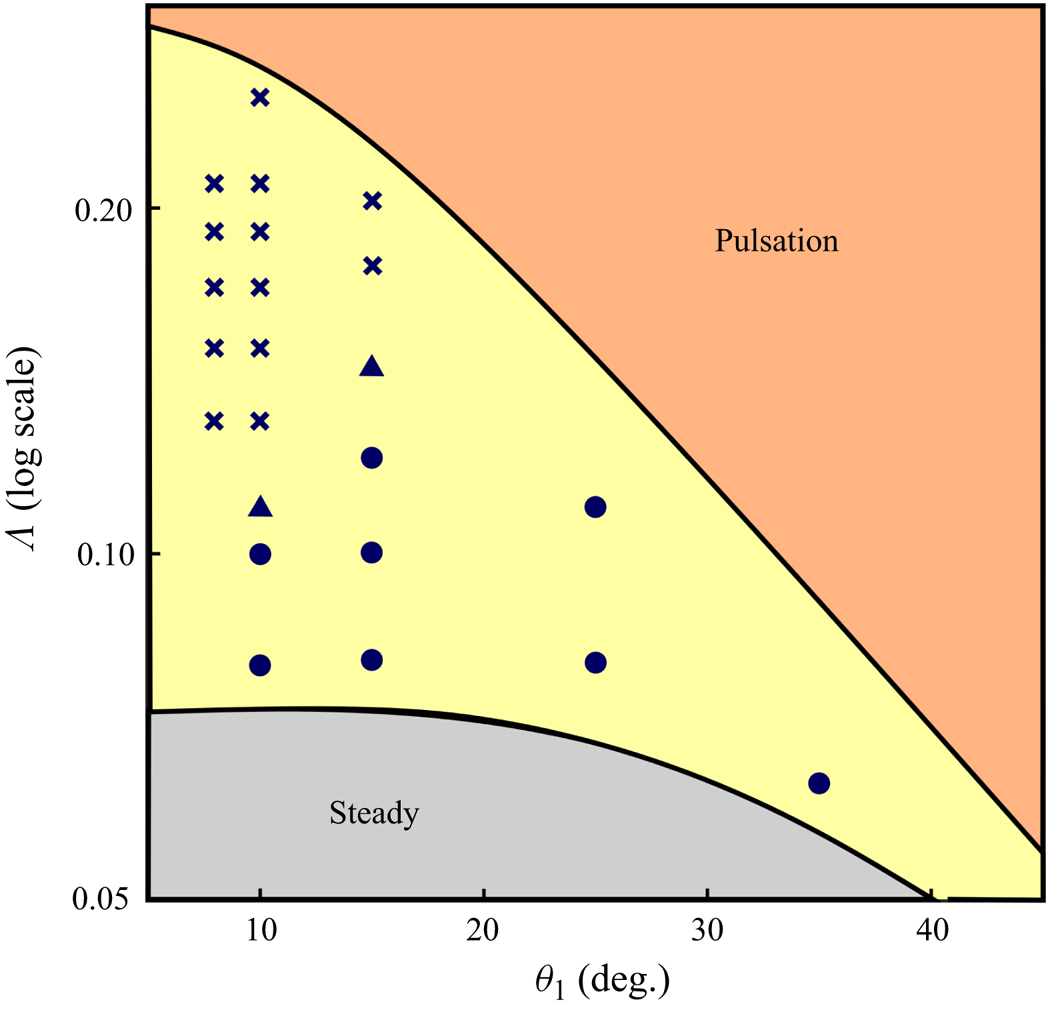
Figure 11. The ![]() $\theta _1$-
$\theta _1$-![]() $\varLambda$ parameter space for the double cone flow with
$\varLambda$ parameter space for the double cone flow with ![]() $\theta _2 = 90^\circ$. The same set of experimental data markers as figure 5(b) are shown here, but the markers are now classified as per oscillation types discussed in § 3.1: free oscillations (
$\theta _2 = 90^\circ$. The same set of experimental data markers as figure 5(b) are shown here, but the markers are now classified as per oscillation types discussed in § 3.1: free oscillations (![]() $\bullet$); anchored oscillations (
$\bullet$); anchored oscillations (![]() $\boldsymbol {\times }$); mixed oscillations that show features of both free and anchored oscillations (
$\boldsymbol {\times }$); mixed oscillations that show features of both free and anchored oscillations (![]() $\blacktriangle$).
$\blacktriangle$).
Qualitative observations from all the schlieren data obtained for flow oscillations in the present work suggest that the unsteady motions of the shear layer, the separation point and the separation and intermediate shock waves are coupled, and contain a single dominant time scale. To extract such a global time scale from the high-speed schlieren data, we apply the technique of spectral proper orthogonal decomposition (SPOD) (Towne, Schmidt & Colonius Reference Towne, Schmidt and Colonius2018). SPOD, which is a frequency-domain variant of the conventional proper orthogonal decomposition (POD), is an effective tool for extracting key temporal scales from high-speed schlieren data where the flow unsteadiness is statistically stationary (Thasu & Duvvuri Reference Thasu and Duvvuri2022). To briefly summarise SPOD implementation with schlieren data, consider an ensemble of realisations of schlieren intensity field ![]() $q(\boldsymbol {x},t) = \{q_i(\boldsymbol {x},t_k),\ i=1,2,\ldots,n; k=1,2,\ldots,m\}$, where
$q(\boldsymbol {x},t) = \{q_i(\boldsymbol {x},t_k),\ i=1,2,\ldots,n; k=1,2,\ldots,m\}$, where ![]() $i$,
$i$, ![]() $n$,
$n$, ![]() $\boldsymbol {x}$,
$\boldsymbol {x}$, ![]() $t_k$ and
$t_k$ and ![]() $m$ are realisation block index, the total number of realisations, spatial coordinate vector, time and number of snapshots in any one of the realisations blocks, respectively. In the present analysis, we use
$m$ are realisation block index, the total number of realisations, spatial coordinate vector, time and number of snapshots in any one of the realisations blocks, respectively. In the present analysis, we use ![]() $n=4$ blocks and the number of snapshots per block (
$n=4$ blocks and the number of snapshots per block (![]() $m$) is in the range 2500–3000 across all experiments. For each data block
$m$) is in the range 2500–3000 across all experiments. For each data block ![]() $i$, the spatiotemporal field
$i$, the spatiotemporal field ![]() $q_i(\boldsymbol {x},t_k)$ is first transformed to power spectral density (PSD) field
$q_i(\boldsymbol {x},t_k)$ is first transformed to power spectral density (PSD) field ![]() $\hat {q}_i(\boldsymbol {x},f_k)$ in the frequency (
$\hat {q}_i(\boldsymbol {x},f_k)$ in the frequency (![]() $f$) domain. Subsequently, the ensemble
$f$) domain. Subsequently, the ensemble ![]() $\hat {q}_i(\boldsymbol {x},f_k)$ consisting of
$\hat {q}_i(\boldsymbol {x},f_k)$ consisting of ![]() $n$ realisations is decomposed into orthogonal modes at individual frequencies through POD:
$n$ realisations is decomposed into orthogonal modes at individual frequencies through POD:
 \begin{equation} \hat{Q}(\boldsymbol{x},f_k) = \sum_{j=1}^n a_{j}(f_k)\psi_{j}(\boldsymbol{x},f_k). \end{equation}
\begin{equation} \hat{Q}(\boldsymbol{x},f_k) = \sum_{j=1}^n a_{j}(f_k)\psi_{j}(\boldsymbol{x},f_k). \end{equation}
This essentially means that SPOD decomposes the ensemble of realisations ![]() $\hat {q}(\boldsymbol {x},f_k)$ into orthogonal modes
$\hat {q}(\boldsymbol {x},f_k)$ into orthogonal modes ![]() $\psi _{j}(\boldsymbol {x},f_k)$ at different frequencies
$\psi _{j}(\boldsymbol {x},f_k)$ at different frequencies ![]() $f_k$, and
$f_k$, and ![]() $\hat {Q}(\boldsymbol {x},f_k)$ represents the optimal reconstruction of the flow data set that contains the maximum energy (variance) of the ensemble. This optimisation problem leads to an eigenvalue decomposition problem, and the eigenvalues corresponding to these modes at different frequencies are represented by
$\hat {Q}(\boldsymbol {x},f_k)$ represents the optimal reconstruction of the flow data set that contains the maximum energy (variance) of the ensemble. This optimisation problem leads to an eigenvalue decomposition problem, and the eigenvalues corresponding to these modes at different frequencies are represented by ![]() $\lambda _j(f_k) = a_{j}^2(f_k)$.
$\lambda _j(f_k) = a_{j}^2(f_k)$.
For the present data set, PSD of the schlieren snapshot matrix was calculated to obtain convergent estimates of spectral density as per the recommendation of Towne et al. (Reference Towne, Schmidt and Colonius2018). As a result, both ![]() $\hat {q}_i(\boldsymbol {x},f_k)$ and
$\hat {q}_i(\boldsymbol {x},f_k)$ and ![]() $\psi _j(\boldsymbol {x},f_k)$ are real-valued fields and can be readily visualised in the form of a 2-D colourmap. The SPOD modes are ranked based on the corresponding
$\psi _j(\boldsymbol {x},f_k)$ are real-valued fields and can be readily visualised in the form of a 2-D colourmap. The SPOD modes are ranked based on the corresponding ![]() $\lambda _j$ values, and then the leading mode can be understood to represent the dominant coherent structure in the flow. Figure 12 shows SPOD results for two specific oscillation cases discussed in § 3.1 (see figure 9). In both cases the leading mode is seen to be much more energetic in comparison with the other modes and, hence, it provides a good representation of the coherent spatial structure present in the flow. A peak in the spectra can be clearly identified in both cases, which indicates the presence of a dominant global time scale that characterises flow unsteadiness, i.e. a characteristic frequency for oscillations
$\lambda _j$ values, and then the leading mode can be understood to represent the dominant coherent structure in the flow. Figure 12 shows SPOD results for two specific oscillation cases discussed in § 3.1 (see figure 9). In both cases the leading mode is seen to be much more energetic in comparison with the other modes and, hence, it provides a good representation of the coherent spatial structure present in the flow. A peak in the spectra can be clearly identified in both cases, which indicates the presence of a dominant global time scale that characterises flow unsteadiness, i.e. a characteristic frequency for oscillations ![]() $f$. A non-dimensional frequency
$f$. A non-dimensional frequency ![]() $St$ (Strouhal number) is defined here as
$St$ (Strouhal number) is defined here as
where ![]() $U_\infty$ is the free-stream velocity. The choice of
$U_\infty$ is the free-stream velocity. The choice of ![]() $l_1$ as the length scale in the above equation is simply based on the fact that it is a fundamental geometric length scale for the double-cone flow. From the spectra plots, the Strouhal numbers for these free- and anchored-oscillation cases are found to be 0.174 and 0.170, respectively. The SPOD analysis outlined here was performed for all the data markers shown in figure 11. The Strouhal number thus obtained for different combinations of
$l_1$ as the length scale in the above equation is simply based on the fact that it is a fundamental geometric length scale for the double-cone flow. From the spectra plots, the Strouhal numbers for these free- and anchored-oscillation cases are found to be 0.174 and 0.170, respectively. The SPOD analysis outlined here was performed for all the data markers shown in figure 11. The Strouhal number thus obtained for different combinations of ![]() $\theta _1$ and
$\theta _1$ and ![]() $\varLambda$ are summarised in figure 13. In passing we note that the schlieren optical settings do not affect the SPOD results or the interpretation drawn from those results.
$\varLambda$ are summarised in figure 13. In passing we note that the schlieren optical settings do not affect the SPOD results or the interpretation drawn from those results.
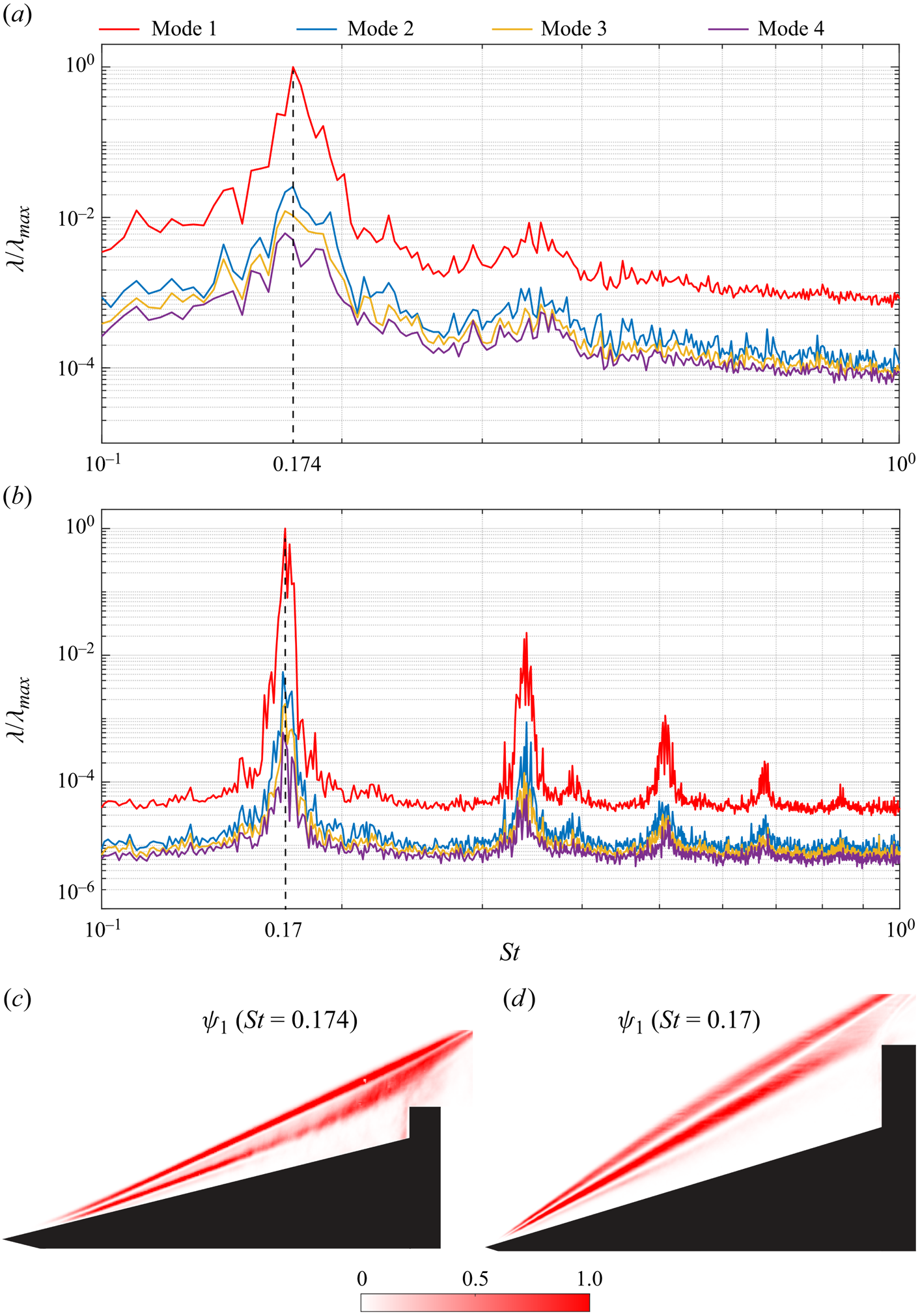
Figure 12. SPOD modal energy spectra normalised by maximum energy of the leading mode and the corresponding mode shape of the leading mode (bottom row). (a,c) Free oscillation for ![]() $\theta _1=15^\circ$ and
$\theta _1=15^\circ$ and ![]() $\varLambda =0.08$. (b,d) Anchored oscillation for
$\varLambda =0.08$. (b,d) Anchored oscillation for ![]() $\theta _1=15^\circ$ and
$\theta _1=15^\circ$ and ![]() $\varLambda =0.20$.
$\varLambda =0.20$.
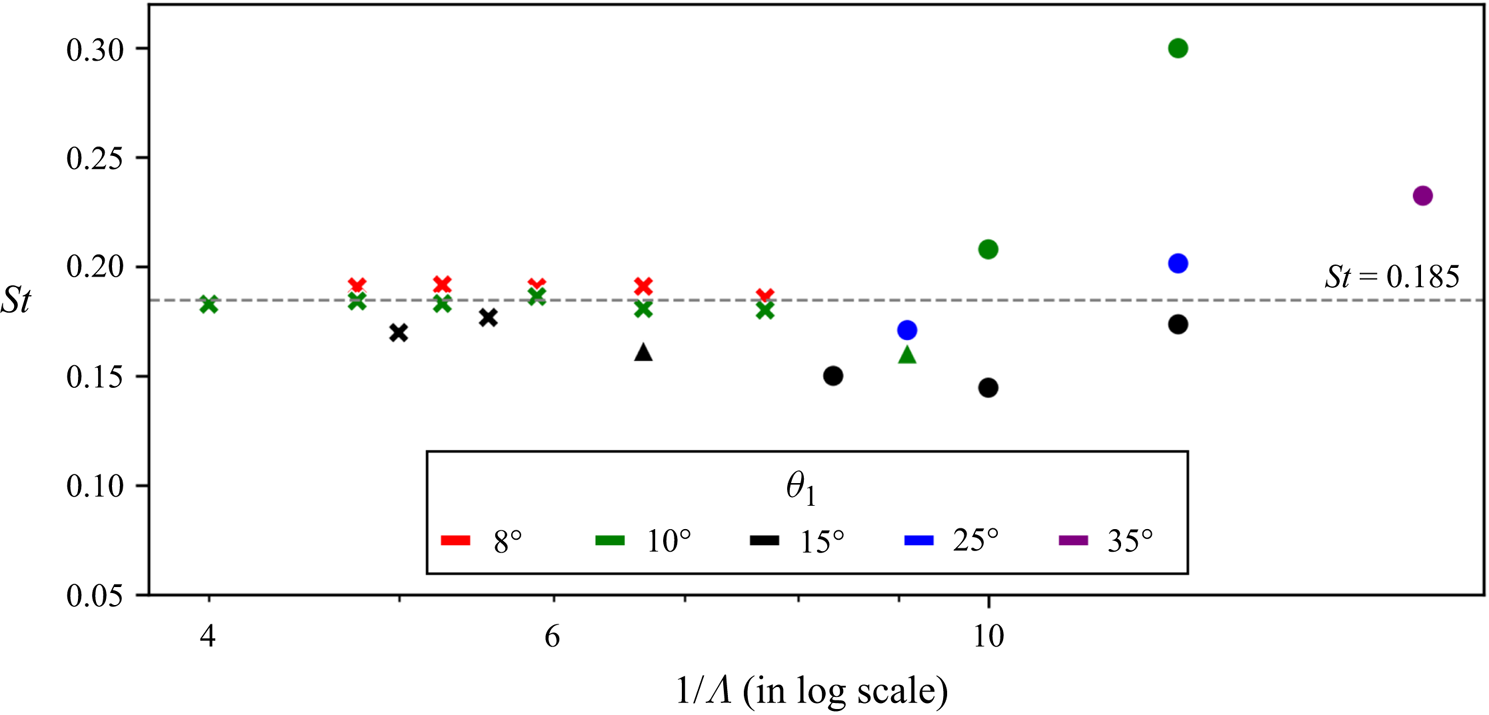
Figure 13. Strouhal number (![]() $St = f l_1/U_\infty$) variation with
$St = f l_1/U_\infty$) variation with ![]() $\theta _1$ and
$\theta _1$ and ![]() $\varLambda$. Marker shapes represent oscillations subtypes: free oscillation (
$\varLambda$. Marker shapes represent oscillations subtypes: free oscillation (![]() $\bullet$); anchored oscillation (
$\bullet$); anchored oscillation (![]() $\boldsymbol {\times }$); mixed oscillation (
$\boldsymbol {\times }$); mixed oscillation (![]() $\blacktriangle$). Marker colour indicates
$\blacktriangle$). Marker colour indicates ![]() $\theta _1$ as per the inset figure legend. The horizontal dashed line marks the average value of
$\theta _1$ as per the inset figure legend. The horizontal dashed line marks the average value of ![]() $St = 0.185$ across all the anchored-oscillation cases.
$St = 0.185$ across all the anchored-oscillation cases.
For anchored oscillations, the Strouhal number seems to be mostly invariant with respect to both ![]() $\theta _1$ and
$\theta _1$ and ![]() $\varLambda$, and shows an average value of
$\varLambda$, and shows an average value of ![]() $St = 0.185$, whereas for free oscillations the Strouhal number exhibits a clear dependency on both
$St = 0.185$, whereas for free oscillations the Strouhal number exhibits a clear dependency on both ![]() $\theta _1$ and
$\theta _1$ and ![]() $\varLambda$. The possible reason for the Strouhal number behaviour observed in figure 13 is discussed in the following section. Figure 14 shows the Strouhal number as a function of the mixed geometric parameter
$\varLambda$. The possible reason for the Strouhal number behaviour observed in figure 13 is discussed in the following section. Figure 14 shows the Strouhal number as a function of the mixed geometric parameter ![]() $(1-\sin ^2\theta _1)/\varLambda$ which combines
$(1-\sin ^2\theta _1)/\varLambda$ which combines ![]() $\theta _1$ and
$\theta _1$ and ![]() $\varLambda$. The data for free oscillations now show an approximately linear trend with
$\varLambda$. The data for free oscillations now show an approximately linear trend with ![]() $(1-\sin ^2\theta _1)/\varLambda$, with reduced scatter in
$(1-\sin ^2\theta _1)/\varLambda$, with reduced scatter in ![]() $St$ as compared with figure 13. In this context it is noted that Mach number
$St$ as compared with figure 13. In this context it is noted that Mach number ![]() $M_o$ decreases with increase in either
$M_o$ decreases with increase in either ![]() $\varLambda$ or
$\varLambda$ or ![]() $\theta _1$ (as shown previously in §§ 3.1 and 3.2). Hence,
$\theta _1$ (as shown previously in §§ 3.1 and 3.2). Hence, ![]() $M_o$ monotonically increases with the parameter
$M_o$ monotonically increases with the parameter ![]() $(1-\sin ^2\theta _1)/\varLambda$. The scaling observed here suggests that
$(1-\sin ^2\theta _1)/\varLambda$. The scaling observed here suggests that ![]() $M_o$ could be an important parameter in determining
$M_o$ could be an important parameter in determining ![]() $St$, and this aspect is naturally incorporated in the aeroacoustic model developed in the following section.
$St$, and this aspect is naturally incorporated in the aeroacoustic model developed in the following section.
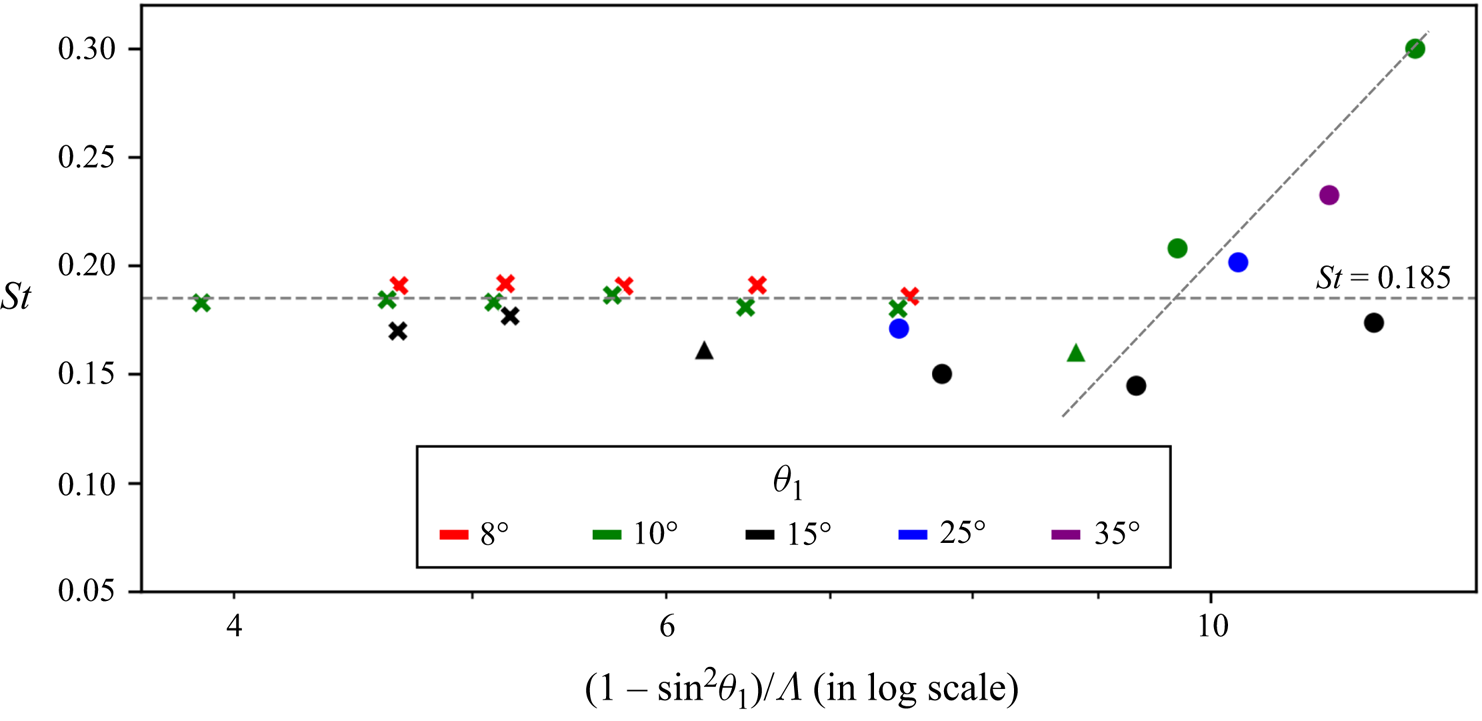
Figure 14. Strouhal number (![]() $St = f l_1/U_\infty$) variation with
$St = f l_1/U_\infty$) variation with ![]() $\theta _1$ and
$\theta _1$ and ![]() $\varLambda$. The horizontal axis is scaled with the parameter
$\varLambda$. The horizontal axis is scaled with the parameter ![]() $(1-\sin ^2\theta _1)/\varLambda$ which combines
$(1-\sin ^2\theta _1)/\varLambda$ which combines ![]() $\theta _1$ and
$\theta _1$ and ![]() $\varLambda$. Figure legend same as that of figure 13. The horizontal dashed line marks the average value of
$\varLambda$. Figure legend same as that of figure 13. The horizontal dashed line marks the average value of ![]() $St = 0.185$ across all the anchored-oscillation cases, whereas the inclined dashed line is a qualitative trend line which highlights the variation in
$St = 0.185$ across all the anchored-oscillation cases, whereas the inclined dashed line is a qualitative trend line which highlights the variation in ![]() $St$ with
$St$ with ![]() $(1-\sin ^2\theta _1)/\varLambda$ for free-oscillation cases.
$(1-\sin ^2\theta _1)/\varLambda$ for free-oscillation cases.
4. An aeroacoustic model for oscillations
The mean flow structure of oscillations over a double cone is shown in a simple schematic manner in figure 15. As discussed in the previous sections, the flow configuration comprises a compressible shear layer sitting over a separation bubble, and impinging at the aft-cone shoulder. This entire configuration exhibits self-sustained coherent flow oscillations in time. It is noted that these flow features have broad similarities to compressible flow over an open cavity, illustrated schematically in figure 16. Both the double-cone and open-cavity configurations comprise of a large separated flow region with a compressible free-shear layer, and exhibit low-frequency flow unsteadiness. The phenomena of flow oscillations in compressible open cavity flows has been studied extensively in the past (Rossiter Reference Rossiter1964; Heller, Holmes & Covert Reference Heller, Holmes and Covert1971; Rockwell & Naudascher Reference Rockwell and Naudascher1978; Tam & Block Reference Tam and Block1978; Rowley, Colonius & Basu Reference Rowley, Colonius and Basu2002; Larchevêque et al. Reference Larchevêque, Sagaut, Mary, Labbé and Comte2003; Kegerise et al. Reference Kegerise, Spina, Garg and Cattafesta2004; Zhuang et al. Reference Zhuang, Alvi, Alkislar and Shih2006; Brès & Colonius Reference Brès and Colonius2008), and it is largely explained through an aeroacoustic feedback mechanism that was first described in detail by Rossiter (Reference Rossiter1964). This feedback mechanism is composed of two phases in a flow cycle (refer to figure 16): (1) the downstream propagation and growth of disturbances in the compressible shear layer; (2) the upstream propagation of acoustic disturbances in the subsonic separated flow region. In this feedback cycle, disturbances at the leading edge of the cavity are excited by the upstream propagating acoustic disturbances and, in turn, the acoustic disturbances at the trailing edge of the cavity are generated due to the impingement of the shear layer disturbances on the cavity trailing edge. Based on this aeroacoustic mechanism, Rossiter (Reference Rossiter1964) proposed the following equation to determine the resonant frequencies of cavity flow oscillations:
 \begin{equation} f = \frac{1}{L}\left(\frac{m-\kappa}{\dfrac{1}{KU}+\dfrac{1}{a_i}}\right). \end{equation}
\begin{equation} f = \frac{1}{L}\left(\frac{m-\kappa}{\dfrac{1}{KU}+\dfrac{1}{a_i}}\right). \end{equation}
Equation (4.1) essentially says that in a cavity of length ![]() $L$, the time period of oscillation (
$L$, the time period of oscillation (![]() $1/f$) is set by the feedback loop which comprises downstream propagating disturbances at a speed proportional to free-stream speed (
$1/f$) is set by the feedback loop which comprises downstream propagating disturbances at a speed proportional to free-stream speed (![]() $U$) and upstream propagating disturbances at acoustic wave speed (
$U$) and upstream propagating disturbances at acoustic wave speed (![]() $a_i$). Here,
$a_i$). Here, ![]() $m$ represents the mode (or overtone) of the natural resonance frequency and
$m$ represents the mode (or overtone) of the natural resonance frequency and ![]() $\kappa$ represents the phase lag between the shear layer disturbance wave and acoustic wave near the trailing edge of the cavity. The proportionality constant (
$\kappa$ represents the phase lag between the shear layer disturbance wave and acoustic wave near the trailing edge of the cavity. The proportionality constant (![]() $K$) has been determined in the literature based on experimental data. Drawing inspiration from the open cavity flow, and based on qualitative observations from our high-speed schlieren data, we hypothesise that an aeroacoustic feedback loop could give rise to oscillations in the double-cone flow. Based on this hypothesis, a model to predict the oscillation frequency is constructed in the following manner.
$K$) has been determined in the literature based on experimental data. Drawing inspiration from the open cavity flow, and based on qualitative observations from our high-speed schlieren data, we hypothesise that an aeroacoustic feedback loop could give rise to oscillations in the double-cone flow. Based on this hypothesis, a model to predict the oscillation frequency is constructed in the following manner.
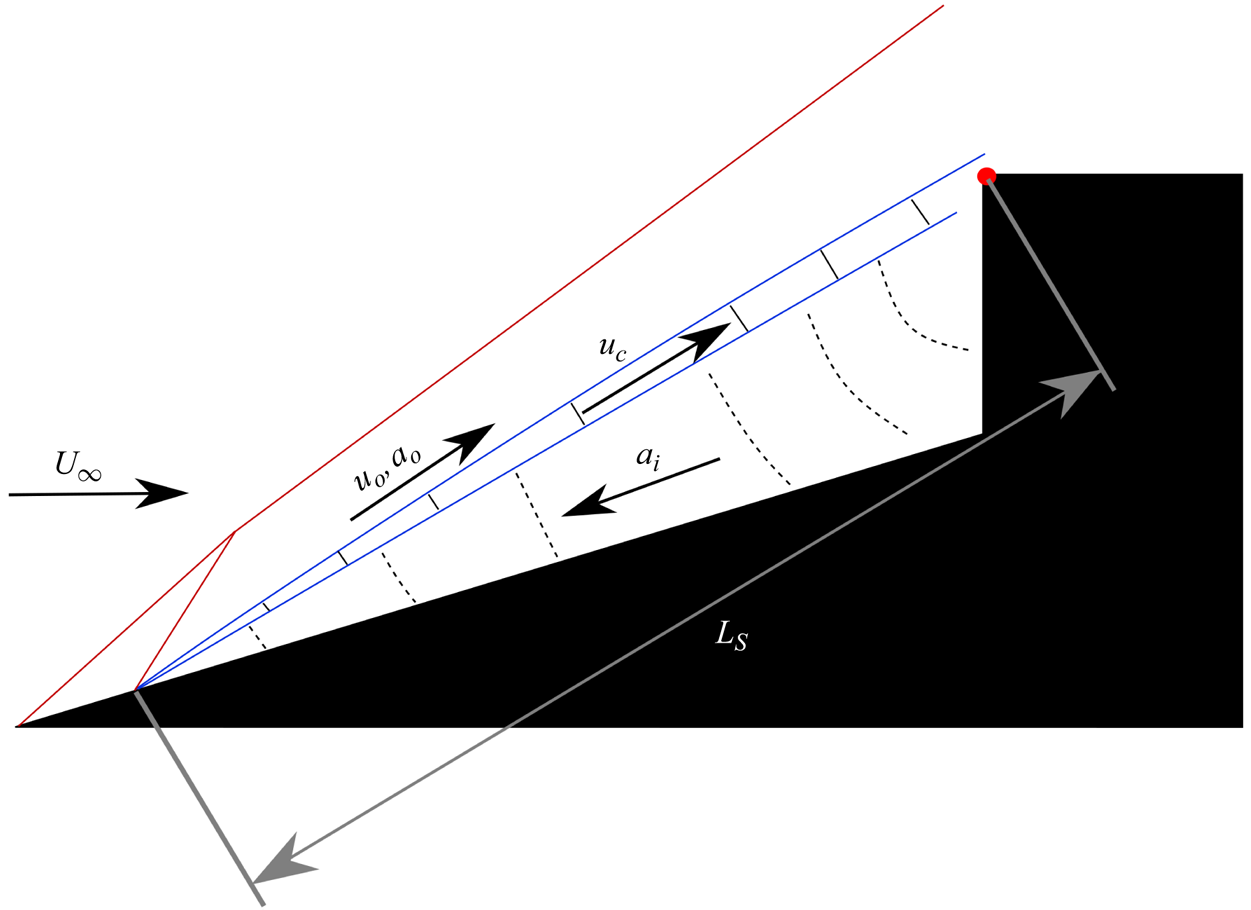
Figure 15. A schematic representation of the proposed aeroacoustic feedback mechanism in the double-cone model.

Figure 16. A schematic representation of the aeroacoustic feedback cycle in an open cavity flow. The disturbances in the shear layer propagate at a fraction of the free-stream speed (![]() $KU$). The shear layer impingement at the trailing edge of the cavity generates acoustic waves that propagate upstream in the separated flow region to influence the shear layer at the leading edge of the cavity.
$KU$). The shear layer impingement at the trailing edge of the cavity generates acoustic waves that propagate upstream in the separated flow region to influence the shear layer at the leading edge of the cavity.
We consider disturbances in the compressible shear layer to propagate downstream at a speed ![]() $u_c$, which is dependent on the flow speed above the shear layer
$u_c$, which is dependent on the flow speed above the shear layer ![]() $u_o$, but not necessarily proportional to
$u_o$, but not necessarily proportional to ![]() $u_o$ as assumed in many of the cavity flow studies at low supersonic Mach numbers. To obtain
$u_o$ as assumed in many of the cavity flow studies at low supersonic Mach numbers. To obtain ![]() $u_c$, we rely on the significant amount of literature available on compressible shear layers, where the flow structure and properties such as growth rate of the shear layer thickness, convection speed of disturbances, growth rate of dominant waves and their structure has been studied in detail (Bogdanoff Reference Bogdanoff1983; Papamoschou & Roshko Reference Papamoschou and Roshko1988; Elliott & Samimy Reference Elliott and Samimy1990; Hall, Dimotakis & Rosemann Reference Hall, Dimotakis and Rosemann1993; Murray & Elliott Reference Murray and Elliott2001; Pantano & Sarkar Reference Pantano and Sarkar2002). According to Papamoschou & Roshko (Reference Papamoschou and Roshko1988), the disturbance speed in the shear layer
$u_c$, we rely on the significant amount of literature available on compressible shear layers, where the flow structure and properties such as growth rate of the shear layer thickness, convection speed of disturbances, growth rate of dominant waves and their structure has been studied in detail (Bogdanoff Reference Bogdanoff1983; Papamoschou & Roshko Reference Papamoschou and Roshko1988; Elliott & Samimy Reference Elliott and Samimy1990; Hall, Dimotakis & Rosemann Reference Hall, Dimotakis and Rosemann1993; Murray & Elliott Reference Murray and Elliott2001; Pantano & Sarkar Reference Pantano and Sarkar2002). According to Papamoschou & Roshko (Reference Papamoschou and Roshko1988), the disturbance speed in the shear layer ![]() $u_c$ can be related to
$u_c$ can be related to ![]() $u_o$ as
$u_o$ as
 \begin{equation} u_c = \frac{u_o}{1+\dfrac{a_o}{a_i}}, \end{equation}
\begin{equation} u_c = \frac{u_o}{1+\dfrac{a_o}{a_i}}, \end{equation}
where the flow speed below the shear layer (in the separation region) is assumed to be zero. Here, ![]() $a_o$ and
$a_o$ and ![]() $a_i$ are the speeds of sound on the high- and low-speed sides of the shear layer, respectively. Extensive experimental studies by Oertel sen (Reference Oertel sen1979, Reference Oertel sen1980, Reference Oertel sen1983) on supersonic jets show that disturbances in a compressible shear layer are primarily comprised of three types, each propagating downstream with a distinct characteristic speed. Subsequently, the existence of these three types of disturbance waves was shown by Tam & Hu (Reference Tam and Hu1989) through harmonic analysis of linearised governing equation of compressible inviscid flow. Some important features of the disturbance waves are briefly summarised here. The first type of disturbance is the Kelvin–Helmholtz (K–H) instability wave, and the second and third types of disturbances are termed as supersonic and subsonic instability waves, respectively. The supersonic instability wave is centered around the shear layer centerline and propagates downstream at a speed slower than K–H instability wave, which is centered in the high-speed side of the shear layer. The subsonic instability mode is centered in the low-speed side of the shear layer and can propagate upstream in the subsonic flow regions of the shear layer. In general, K–H and supersonic instability waves show weak dependence on the shear layer thickness, whereas the subsonic wave is sensitive to the shear layer thickness and exhibits neutral stability for the theoretical case of zero shear layer thickness. Based on the theoretical and experimental understanding of the disturbance waves present in a compressible shear layer (Tam Reference Tam1971; Tam & Hu Reference Tam and Hu1989; Tam Reference Tam2009; Oertel sen, Seiler & Srulijes Reference Oertel sen, Seiler and Srulijes2010), a vortex train model was proposed by Oertel sen et al. (Reference Oertel sen, Seiler, Srulijes and Hruschka2016) to obtain the propagation speeds for the three types of disturbances. For a shear layer with flow speed
$a_i$ are the speeds of sound on the high- and low-speed sides of the shear layer, respectively. Extensive experimental studies by Oertel sen (Reference Oertel sen1979, Reference Oertel sen1980, Reference Oertel sen1983) on supersonic jets show that disturbances in a compressible shear layer are primarily comprised of three types, each propagating downstream with a distinct characteristic speed. Subsequently, the existence of these three types of disturbance waves was shown by Tam & Hu (Reference Tam and Hu1989) through harmonic analysis of linearised governing equation of compressible inviscid flow. Some important features of the disturbance waves are briefly summarised here. The first type of disturbance is the Kelvin–Helmholtz (K–H) instability wave, and the second and third types of disturbances are termed as supersonic and subsonic instability waves, respectively. The supersonic instability wave is centered around the shear layer centerline and propagates downstream at a speed slower than K–H instability wave, which is centered in the high-speed side of the shear layer. The subsonic instability mode is centered in the low-speed side of the shear layer and can propagate upstream in the subsonic flow regions of the shear layer. In general, K–H and supersonic instability waves show weak dependence on the shear layer thickness, whereas the subsonic wave is sensitive to the shear layer thickness and exhibits neutral stability for the theoretical case of zero shear layer thickness. Based on the theoretical and experimental understanding of the disturbance waves present in a compressible shear layer (Tam Reference Tam1971; Tam & Hu Reference Tam and Hu1989; Tam Reference Tam2009; Oertel sen, Seiler & Srulijes Reference Oertel sen, Seiler and Srulijes2010), a vortex train model was proposed by Oertel sen et al. (Reference Oertel sen, Seiler, Srulijes and Hruschka2016) to obtain the propagation speeds for the three types of disturbances. For a shear layer with flow speed ![]() $u_o$ on the high-speed side and stationary fluid on the low-speed side, the propagation speed can be expressed as
$u_o$ on the high-speed side and stationary fluid on the low-speed side, the propagation speed can be expressed as
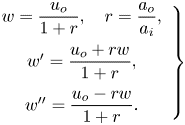 \begin{equation} \left.\begin{array}{c} w = \dfrac{u_o}{1+r}, \quad r = \dfrac{a_o}{a_i},\\ w' = \dfrac{u_o+rw}{1+r},\\ w'' = \dfrac{u_o-rw}{1+r}. \end{array}\right\} \end{equation}
\begin{equation} \left.\begin{array}{c} w = \dfrac{u_o}{1+r}, \quad r = \dfrac{a_o}{a_i},\\ w' = \dfrac{u_o+rw}{1+r},\\ w'' = \dfrac{u_o-rw}{1+r}. \end{array}\right\} \end{equation}
In the above equation ![]() $w$,
$w$, ![]() $w'$ and
$w'$ and ![]() $w''$ represent propagation speeds of supersonic, K–H and subsonic instability waves. Here,
$w''$ represent propagation speeds of supersonic, K–H and subsonic instability waves. Here, ![]() $a_o$ and
$a_o$ and ![]() $a_i$ are the speeds of sound on the high- and low-speed sides of the shear layer, respectively. A more detailed derivation of expressions in (4.3) can be found in Oertel sen et al. (Reference Oertel sen, Seiler, Srulijes and Hruschka2016). A schematic representation of the compressible shear layer based on the vortex train model of Oertel sen et al. (Reference Oertel sen, Seiler, Srulijes and Hruschka2016) is shown in figure 17. It is noted here that the speed
$a_i$ are the speeds of sound on the high- and low-speed sides of the shear layer, respectively. A more detailed derivation of expressions in (4.3) can be found in Oertel sen et al. (Reference Oertel sen, Seiler, Srulijes and Hruschka2016). A schematic representation of the compressible shear layer based on the vortex train model of Oertel sen et al. (Reference Oertel sen, Seiler, Srulijes and Hruschka2016) is shown in figure 17. It is noted here that the speed ![]() $u_c$ obtained from (4.2) is same as the speed
$u_c$ obtained from (4.2) is same as the speed ![]() $w$ obtained from (4.3). Thus, for a known flow speed
$w$ obtained from (4.3). Thus, for a known flow speed ![]() $u_o$, and
$u_o$, and ![]() $a_o/a_i$, the downstream propagation speeds of the three types of disturbances in the compressible shear layer can be estimated.
$a_o/a_i$, the downstream propagation speeds of the three types of disturbances in the compressible shear layer can be estimated.

Figure 17. A schematic representation of the compressible shear layer (separated boundary layer) based on the vortex train model proposed by Oertel sen et al. (Reference Oertel sen, Seiler, Srulijes and Hruschka2016). The flow speeds on either sides of the shear layer are ![]() $u_{i}$ (= 0) and
$u_{i}$ (= 0) and ![]() $u_o$, corresponding to the stagnant flow in the separation bubble and supersonic flow above the shear layer, respectively.
$u_o$, corresponding to the stagnant flow in the separation bubble and supersonic flow above the shear layer, respectively.
In the double-cone flow, acoustic waves are generated when the unsteady shear layer impinges at the shoulder of the aft-cone model, and the acoustic waves can travel upstream inside the subsonic separated flow region. This is very similar to the aeroacoustic mechanism that is at play in the open cavity flow. Considering that the fluid inside the separation bubble is nearly stagnant, the acoustic wave propagation speed ![]() $a_i$ can be estimated from the average local temperature in the bubble. In supersonic cavity flow literature, the average local temperature is considered same as the stagnation temperature
$a_i$ can be estimated from the average local temperature in the bubble. In supersonic cavity flow literature, the average local temperature is considered same as the stagnation temperature ![]() $T_0$ (Rockwell & Naudascher Reference Rockwell and Naudascher1978). This assumption, however, does not hold very well at high supersonic Mach numbers (
$T_0$ (Rockwell & Naudascher Reference Rockwell and Naudascher1978). This assumption, however, does not hold very well at high supersonic Mach numbers (![]() $M_o = u_o/a_o$) due to high viscous dissipation in the shear layer. A better estimate for average local temperature in the separation bubble can be obtained by calculating the recovery temperature inside the separation bubble which accounts for the viscous losses in the shear layer (Anderson Reference Anderson2016)
$M_o = u_o/a_o$) due to high viscous dissipation in the shear layer. A better estimate for average local temperature in the separation bubble can be obtained by calculating the recovery temperature inside the separation bubble which accounts for the viscous losses in the shear layer (Anderson Reference Anderson2016)
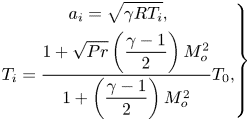 \begin{equation} \left.\begin{gathered} a_i = \sqrt{\gamma R T_i},\\ T_i = \frac{1 + \sqrt{Pr} \left(\dfrac{\gamma-1}{2}\right) M_o^2}{1+\left(\dfrac{\gamma-1}{2}\right)M_o^2} T_0, \end{gathered}\right\} \end{equation}
\begin{equation} \left.\begin{gathered} a_i = \sqrt{\gamma R T_i},\\ T_i = \frac{1 + \sqrt{Pr} \left(\dfrac{\gamma-1}{2}\right) M_o^2}{1+\left(\dfrac{\gamma-1}{2}\right)M_o^2} T_0, \end{gathered}\right\} \end{equation}
where ![]() $T_0$ is the flow stagnation temperature in the free stream, and
$T_0$ is the flow stagnation temperature in the free stream, and ![]() $\gamma$ and
$\gamma$ and ![]() $Pr$ are the ratio of specific heats and the Prandtl number, respectively, for air.
$Pr$ are the ratio of specific heats and the Prandtl number, respectively, for air.
We can now use the ansatz of Rossiter's model to work out an expression for the Strouhal number of flow oscillations over a double cone. From (3.4) and (4.1), we have
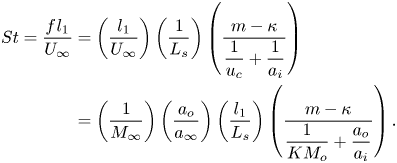 \begin{align} St = \frac{f\kern 0.06em l_1}{U_\infty} &= \left(\frac{l_1}{U_\infty}\right)\left(\frac{1}{L_s}\right) \left(\frac{m-\kappa}{\dfrac{1}{u_c}+\dfrac{1}{a_i}}\right)\nonumber\\ & =\left(\frac{1}{M_\infty}\right)\left(\frac{a_o}{a_\infty}\right) \left(\frac{l_1}{L_s}\right)\left(\frac{m-\kappa}{\dfrac{1}{KM_o}+\dfrac{a_o}{a_i}}\right). \end{align}
\begin{align} St = \frac{f\kern 0.06em l_1}{U_\infty} &= \left(\frac{l_1}{U_\infty}\right)\left(\frac{1}{L_s}\right) \left(\frac{m-\kappa}{\dfrac{1}{u_c}+\dfrac{1}{a_i}}\right)\nonumber\\ & =\left(\frac{1}{M_\infty}\right)\left(\frac{a_o}{a_\infty}\right) \left(\frac{l_1}{L_s}\right)\left(\frac{m-\kappa}{\dfrac{1}{KM_o}+\dfrac{a_o}{a_i}}\right). \end{align}
Here ![]() $L_s$ is the shear layer length measured from the separation point to the reattachment point. In the present model, the disturbance propagation speed
$L_s$ is the shear layer length measured from the separation point to the reattachment point. In the present model, the disturbance propagation speed ![]() $u_c$ can take one of three values (
$u_c$ can take one of three values (![]() $w$,
$w$, ![]() $w'$ or
$w'$ or ![]() $w''$). Here the parameter
$w''$). Here the parameter ![]() $K$ is defined as the ratio
$K$ is defined as the ratio ![]() $u_c/u_o$, which according to (4.3) is a function of
$u_c/u_o$, which according to (4.3) is a function of ![]() $r = a_o/a_i$ (unlike open cavity flow models where it is taken to be a constant). The dominant frequency is obtained with the first mode of oscillation (
$r = a_o/a_i$ (unlike open cavity flow models where it is taken to be a constant). The dominant frequency is obtained with the first mode of oscillation (![]() $m = 1$), and the value of
$m = 1$), and the value of ![]() $\kappa$ is determined by the phase difference between the downstream propagating disturbances in the shear layer and the acoustic wave generated at the shoulder of the double cone model. In the present model,
$\kappa$ is determined by the phase difference between the downstream propagating disturbances in the shear layer and the acoustic wave generated at the shoulder of the double cone model. In the present model, ![]() $\kappa = 0.25$ corresponding to a phase difference of
$\kappa = 0.25$ corresponding to a phase difference of ![]() $90^\circ$ is assumed based on the previous literature on open cavity flows (Rockwell & Naudascher Reference Rockwell and Naudascher1978). The ratios
$90^\circ$ is assumed based on the previous literature on open cavity flows (Rockwell & Naudascher Reference Rockwell and Naudascher1978). The ratios ![]() $a_o/a_i$,
$a_o/a_i$, ![]() $a_o/a_\infty$ and
$a_o/a_\infty$ and ![]() $K$ are obtained using the following expressions:
$K$ are obtained using the following expressions:
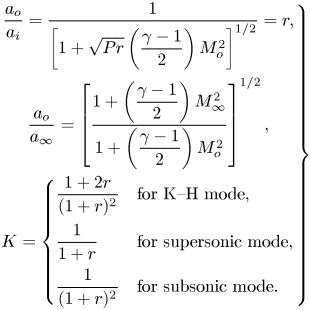 \begin{equation} \left.\begin{gathered} \frac{a_o}{a_i} = \frac{1}{\left[1 + \sqrt{Pr} \left(\dfrac{\gamma-1}{2}\right) M_o^2\right]^{1/2}} = r,\\ \frac{a_o}{a_\infty} = \left[\frac{1 + \left(\dfrac{\gamma-1}{2}\right)M_\infty^2}{1 + \left(\dfrac{\gamma-1}{2}\right) M_o^2}\right]^{1/2},\\ K = \begin{cases} \dfrac{1+2r}{(1+r)^2} & \text{for K--H mode},\\ \dfrac{1}{1+r} & \text{for supersonic mode},\\ \dfrac{1}{(1+r)^2} & \text{for subsonic mode}. \end{cases} \end{gathered}\right\} \end{equation}
\begin{equation} \left.\begin{gathered} \frac{a_o}{a_i} = \frac{1}{\left[1 + \sqrt{Pr} \left(\dfrac{\gamma-1}{2}\right) M_o^2\right]^{1/2}} = r,\\ \frac{a_o}{a_\infty} = \left[\frac{1 + \left(\dfrac{\gamma-1}{2}\right)M_\infty^2}{1 + \left(\dfrac{\gamma-1}{2}\right) M_o^2}\right]^{1/2},\\ K = \begin{cases} \dfrac{1+2r}{(1+r)^2} & \text{for K--H mode},\\ \dfrac{1}{1+r} & \text{for supersonic mode},\\ \dfrac{1}{(1+r)^2} & \text{for subsonic mode}. \end{cases} \end{gathered}\right\} \end{equation} Using (4.6) in (4.5), the input parameters to calculate ![]() $St$ for a given double cone model are simply
$St$ for a given double cone model are simply ![]() $M_\infty$,
$M_\infty$, ![]() $M_o$ and
$M_o$ and ![]() $L_s/l_1$. In the present study, free-stream Mach number
$L_s/l_1$. In the present study, free-stream Mach number ![]() $M_\infty = 6$,
$M_\infty = 6$, ![]() $\gamma = 1.4$,
$\gamma = 1.4$, ![]() $Pr = 0.71$ and the non-dimensional shear layer length (
$Pr = 0.71$ and the non-dimensional shear layer length (![]() $L_s/l_1$) is estimated from a time-averaged schlieren image for any particular experiment. It is noted that this simple model does not account for temporal fluctuations in
$L_s/l_1$) is estimated from a time-averaged schlieren image for any particular experiment. It is noted that this simple model does not account for temporal fluctuations in ![]() $L_s$. An accurate estimate for
$L_s$. An accurate estimate for ![]() $M_o$, however, is not easy to obtain for all the oscillation cases using the schlieren data. For the anchored oscillation cases where the shear layer separates at the cone nose, the separation shock wave angle and the downstream flow properties can be calculated by considering flow deflection from an effective cone with half-angle (
$M_o$, however, is not easy to obtain for all the oscillation cases using the schlieren data. For the anchored oscillation cases where the shear layer separates at the cone nose, the separation shock wave angle and the downstream flow properties can be calculated by considering flow deflection from an effective cone with half-angle (![]() $\theta _1+\theta _s$) and solving the Taylor–Maccoll equation (Anderson Reference Anderson2016). Here,
$\theta _1+\theta _s$) and solving the Taylor–Maccoll equation (Anderson Reference Anderson2016). Here, ![]() $\theta _s$ is the shear layer angle obtained from the time-averaged schlieren data. However, for free-oscillation cases, the downstream flow properties which depend on the successive flow deflections from the nose and separation shock waves cannot be calculated using approximations made in the Taylor–Maccoll equation. Hence, to accurately obtain flow Mach number above the shear layer (
$\theta _s$ is the shear layer angle obtained from the time-averaged schlieren data. However, for free-oscillation cases, the downstream flow properties which depend on the successive flow deflections from the nose and separation shock waves cannot be calculated using approximations made in the Taylor–Maccoll equation. Hence, to accurately obtain flow Mach number above the shear layer (![]() $M_o$) we utilise simple flow simulations, which are summarised in the following.
$M_o$) we utilise simple flow simulations, which are summarised in the following.
Two-dimensional axisymmetric inviscid computational fluid dynamics (CFD) simulations were performed using a compressible flow solver in OpenFOAM (Kumar & De Reference Kumar and De2021b, Reference Kumar and De2022). These simulations are fairly inexpensive due to steady, inviscid and 2-D axisymmetric nature of the flow simulations. A representative domain for a double-cone model with ![]() $\theta _1 = 35^\circ$ and
$\theta _1 = 35^\circ$ and ![]() $\varLambda = 0.06$ is shown in figure 18 (lines
$\varLambda = 0.06$ is shown in figure 18 (lines ![]() $ABCDEF$ drawn in blue colour). The slip boundaries
$ABCDEF$ drawn in blue colour). The slip boundaries ![]() $AB$ and
$AB$ and ![]() $BC$ coincide with the fore-cone surface and observed shear layer in the time-averaged schlieren image, respectively. Free-stream conditions from the experiment are imposed at the boundary
$BC$ coincide with the fore-cone surface and observed shear layer in the time-averaged schlieren image, respectively. Free-stream conditions from the experiment are imposed at the boundary ![]() $AF$, and
$AF$, and ![]() $CDEF$ is considered as non-reflecting far-field boundary. The inviscid axisymmetric simulation with a slip boundary BC accounts for the flow turn at point
$CDEF$ is considered as non-reflecting far-field boundary. The inviscid axisymmetric simulation with a slip boundary BC accounts for the flow turn at point ![]() $B$ due to presence of shear layer in the experiment. The conical shock wave
$B$ due to presence of shear layer in the experiment. The conical shock wave ![]() $AG$, separation shock wave
$AG$, separation shock wave ![]() $BG$, intermediate shock wave
$BG$, intermediate shock wave ![]() $GH$ and a weak shock wave
$GH$ and a weak shock wave ![]() $GI$ obtained from the numerical simulation are found to be in very close agreement with the experimental schlieren image. The Mach number at surface
$GI$ obtained from the numerical simulation are found to be in very close agreement with the experimental schlieren image. The Mach number at surface ![]() $BC$ obtained from CFD simulations is considered as the average Mach number above the shear layer (
$BC$ obtained from CFD simulations is considered as the average Mach number above the shear layer (![]() $M_o$) for modelling purposes. The values of
$M_o$) for modelling purposes. The values of ![]() $L_s/l_1$,
$L_s/l_1$, ![]() $M_o$,
$M_o$, ![]() $a_o/a_i$ and
$a_o/a_i$ and ![]() $St$ for all the experimental cases are tabulated in table 1. From the table it is seen that for any given
$St$ for all the experimental cases are tabulated in table 1. From the table it is seen that for any given ![]() $\theta _1$,
$\theta _1$, ![]() $M_o$ decreases with increasing
$M_o$ decreases with increasing ![]() $\varLambda$ as a consequence of increasing separation region size. In addition,
$\varLambda$ as a consequence of increasing separation region size. In addition, ![]() $M_o$ decreases with increasing
$M_o$ decreases with increasing ![]() $\theta _1$ (see cases with
$\theta _1$ (see cases with ![]() $\varLambda \approx 0.2$) as the conical shock wave angle increases at the cone nose. These observations are consistent with the earlier discussion in § 3. In passing we note that the aeroacoustic model is agnostic to the exact method used to estimate
$\varLambda \approx 0.2$) as the conical shock wave angle increases at the cone nose. These observations are consistent with the earlier discussion in § 3. In passing we note that the aeroacoustic model is agnostic to the exact method used to estimate ![]() $M_o$. While it is easy to estimate
$M_o$. While it is easy to estimate ![]() $M_o$ with simple 2-D axisymmetric inviscid CFD (as shown above), one can also resort to detailed analytical calculations by taking into account the shock wave structure that forms in the case of free oscillations.
$M_o$ with simple 2-D axisymmetric inviscid CFD (as shown above), one can also resort to detailed analytical calculations by taking into account the shock wave structure that forms in the case of free oscillations.
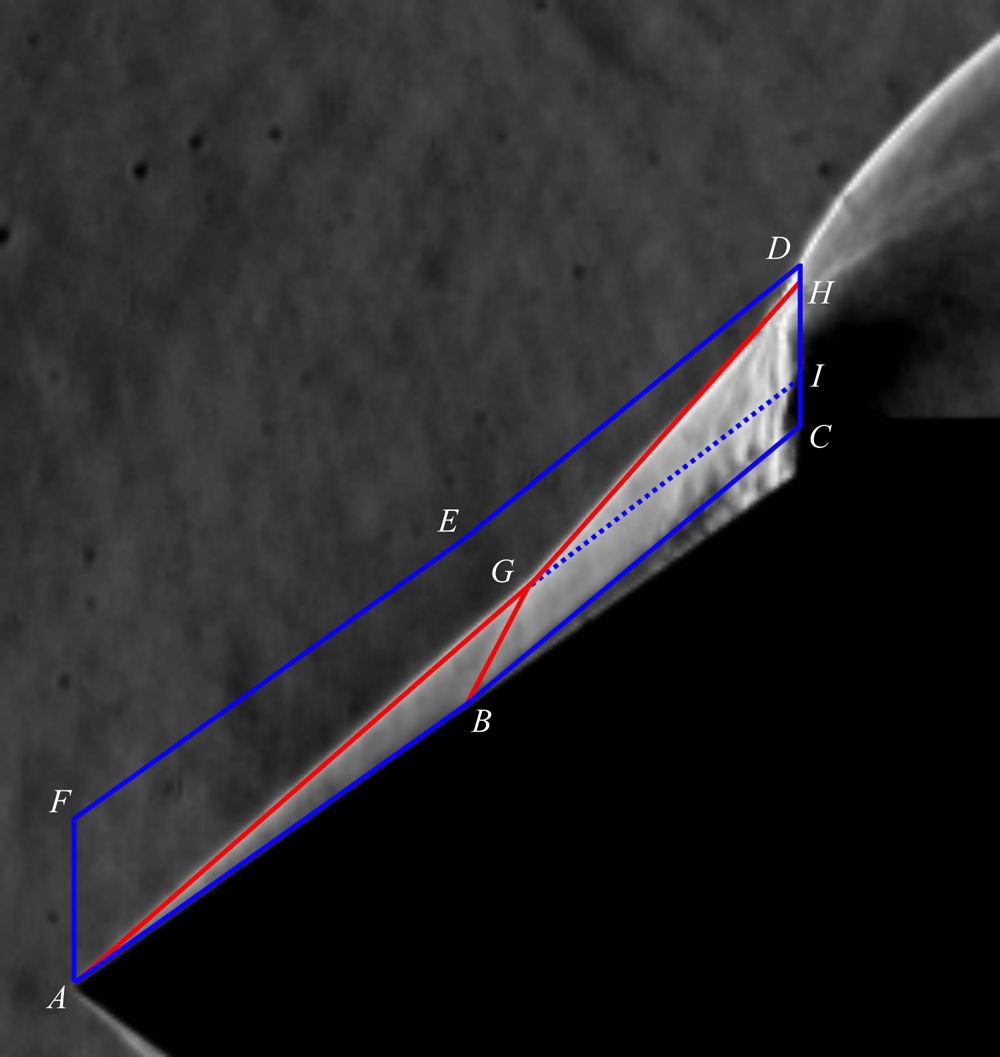
Figure 18. A representative CFD domain ![]() $ABCDEF$ for the axisymmetric inviscid flow simulation over a double-cone model with
$ABCDEF$ for the axisymmetric inviscid flow simulation over a double-cone model with ![]() $\theta _1 = 35^\circ$ and
$\theta _1 = 35^\circ$ and ![]() $\varLambda = 0.06$. Simulated Shock waves and shear layer are shown with solid red and dashed blue lines, respectively.
$\varLambda = 0.06$. Simulated Shock waves and shear layer are shown with solid red and dashed blue lines, respectively.
Table 1. Measured values of non-dimensional shear layer length (![]() $L_s/l_1$) and Strouhal number (
$L_s/l_1$) and Strouhal number (![]() $St$), estimated values of Mach number (
$St$), estimated values of Mach number (![]() $M_o$) and modelled values of Strouhal number based on three types of disturbances waves in the shear layer (
$M_o$) and modelled values of Strouhal number based on three types of disturbances waves in the shear layer (![]() $St_{KH}$,
$St_{KH}$, ![]() $St_{sup}$ and
$St_{sup}$ and ![]() $St_{sub}$) for all the considered experimental cases.
$St_{sub}$) for all the considered experimental cases.
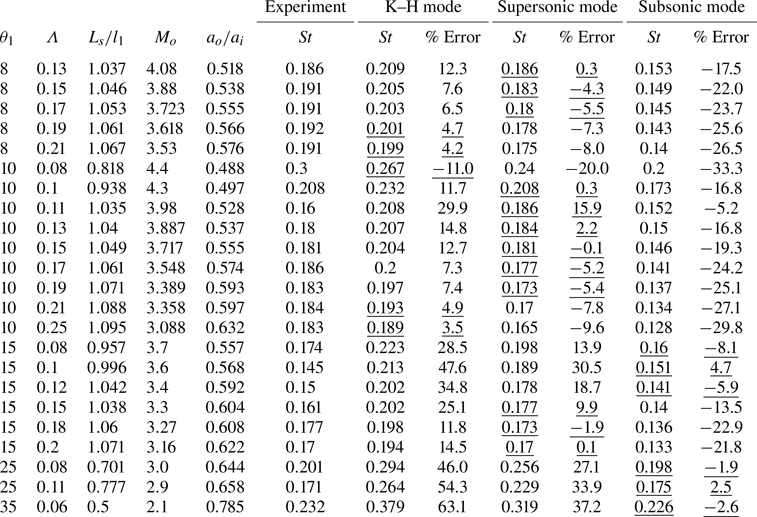
Using the aeroacoustic model developed here ((4.5) and (4.6)), three values of Strouhal numbers, corresponding to three types of disturbance waves in the shear layer, are estimated for each combination of ![]() $\theta _1$ and
$\theta _1$ and ![]() $\varLambda$ studied experimentally. Figure 19 shows a comparison of
$\varLambda$ studied experimentally. Figure 19 shows a comparison of ![]() $St$ obtained from experiments and the model predictions for
$St$ obtained from experiments and the model predictions for ![]() $\theta _1 = 10^\circ$ and
$\theta _1 = 10^\circ$ and ![]() $15^\circ$ as representative cases (comparisons for other values of
$15^\circ$ as representative cases (comparisons for other values of ![]() $\theta _1$ can be found in table 1). It is seen that
$\theta _1$ can be found in table 1). It is seen that ![]() $St$ predictions from the model for anchored oscillations are largely accurate when the supersonic mode speed is used for
$St$ predictions from the model for anchored oscillations are largely accurate when the supersonic mode speed is used for ![]() $u_c$. Though for
$u_c$. Though for ![]() $\theta _1 = 10^\circ$ and large values of
$\theta _1 = 10^\circ$ and large values of ![]() $\varLambda$, it appears that the K–H mode speed gives a better prediction. For free oscillations, the use of supersonic and subsonic mode speeds for
$\varLambda$, it appears that the K–H mode speed gives a better prediction. For free oscillations, the use of supersonic and subsonic mode speeds for ![]() $u_c$ gives a reasonably good prediction. Similar observations can be made in table 1 in terms of comparison between
$u_c$ gives a reasonably good prediction. Similar observations can be made in table 1 in terms of comparison between ![]() $St$ from experiments and model predictions at other values of
$St$ from experiments and model predictions at other values of ![]() $\theta _1$. These observations are consistent with the fact that for a zero-thickness shear layer (the case of anchored oscillations where the boundary layer separates at the cone tip with nominally zero boundary layer thickness), the subsonic disturbance mode is neutrally stable, thereby rendering the supersonic and K–H modes as the dominant modes that drive anchored oscillations. For free oscillations, a finite thickness of the shear layer promotes dominance of the subsonic mode, and thereby the oscillations are mostly driven by the same. The estimated values of
$\theta _1$. These observations are consistent with the fact that for a zero-thickness shear layer (the case of anchored oscillations where the boundary layer separates at the cone tip with nominally zero boundary layer thickness), the subsonic disturbance mode is neutrally stable, thereby rendering the supersonic and K–H modes as the dominant modes that drive anchored oscillations. For free oscillations, a finite thickness of the shear layer promotes dominance of the subsonic mode, and thereby the oscillations are mostly driven by the same. The estimated values of ![]() $St$ for all the experiments in the present study are also tabulated in table 1, where the values closest to the experimentally observed
$St$ for all the experiments in the present study are also tabulated in table 1, where the values closest to the experimentally observed ![]() $St$ are underlined. It is noted that availability of additional data, particularly from detailed computations of the double-cone flow, will add further support to the model, and possibly aid in establishing a more conclusive relationship between the oscillation type and dominant shear layer disturbance mode that sustains the oscillations.
$St$ are underlined. It is noted that availability of additional data, particularly from detailed computations of the double-cone flow, will add further support to the model, and possibly aid in establishing a more conclusive relationship between the oscillation type and dominant shear layer disturbance mode that sustains the oscillations.
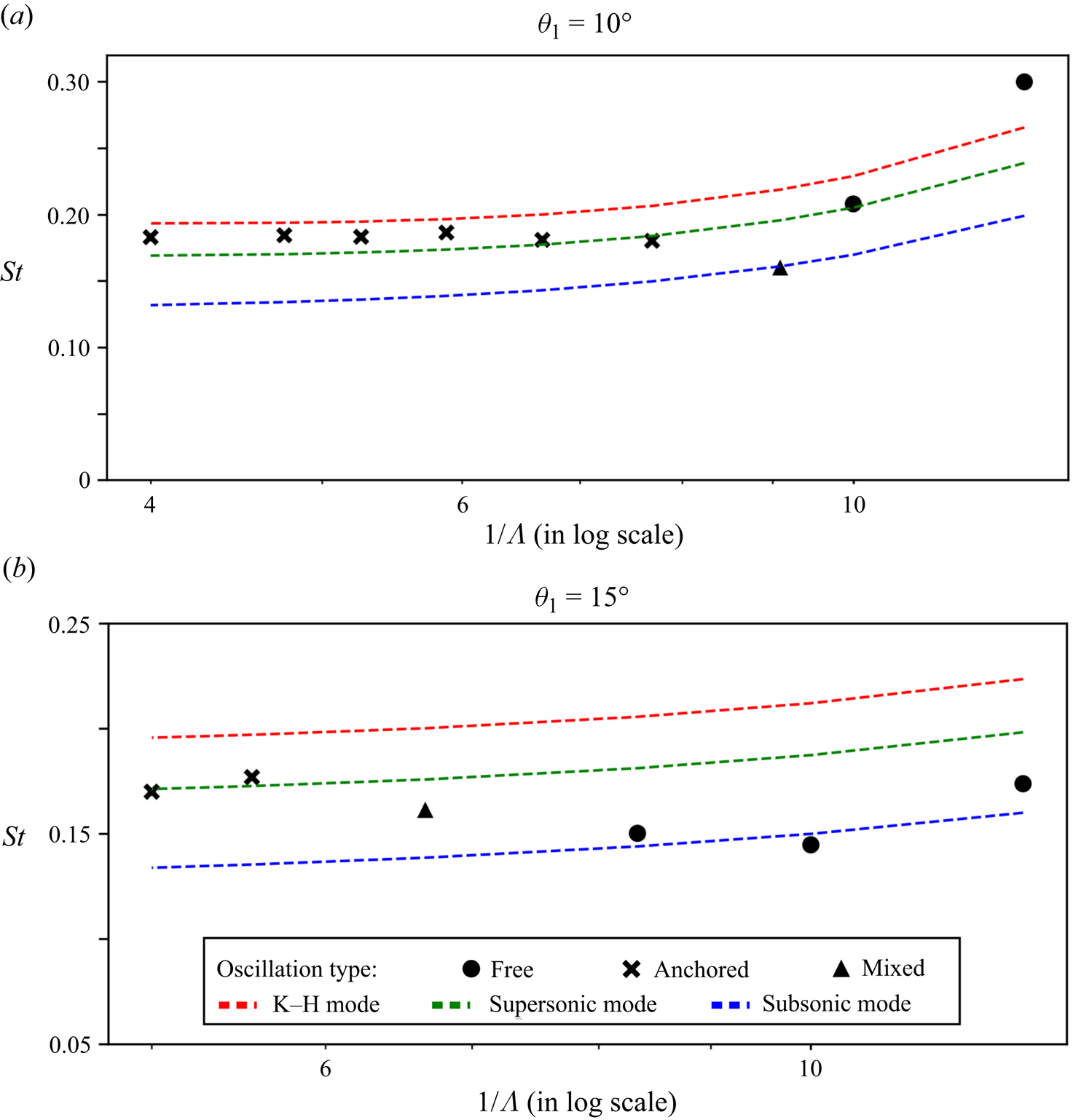
Figure 19. A comparison of predicted Strouhal number (![]() $St$) from three instability types/modes of the shear layer (K–H mode, supersonic mode and subsonic mode) with experimentally observed Strouhal number for (a)
$St$) from three instability types/modes of the shear layer (K–H mode, supersonic mode and subsonic mode) with experimentally observed Strouhal number for (a) ![]() $\theta _1 = 10^\circ$ and (b)
$\theta _1 = 10^\circ$ and (b) ![]() $\theta _1 = 15^\circ$. Data markers are experimental results, with marker shapes representing different oscillations subtypes: free oscillation (
$\theta _1 = 15^\circ$. Data markers are experimental results, with marker shapes representing different oscillations subtypes: free oscillation (![]() $\bullet$); anchored oscillation (
$\bullet$); anchored oscillation (![]() $\boldsymbol {\times }$); mixed oscillation (
$\boldsymbol {\times }$); mixed oscillation (![]() $\blacktriangle$). The dashed curves are quadratic polynomial fits to Strouhal number predictions (from the model) given in table 1.
$\blacktriangle$). The dashed curves are quadratic polynomial fits to Strouhal number predictions (from the model) given in table 1.
Finally, we return to the observation made in figure 13 regarding the invariant behaviour of ![]() $St$ for anchored oscillations. From the model we know that two length scales come into play in determining
$St$ for anchored oscillations. From the model we know that two length scales come into play in determining ![]() $St$, one is the downstream propagation distance for shear layer disturbances and the other is the upstream propagation distance for acoustic disturbance in the separated region. For the case of anchored oscillations, where the separation point is at the cone nose, which is also where the shear layer originates, both the relevant length scales are approximately equal to
$St$, one is the downstream propagation distance for shear layer disturbances and the other is the upstream propagation distance for acoustic disturbance in the separated region. For the case of anchored oscillations, where the separation point is at the cone nose, which is also where the shear layer originates, both the relevant length scales are approximately equal to ![]() $l_1$, the slant length of the fore cone. Since
$l_1$, the slant length of the fore cone. Since ![]() $l_1$ is the length scale used for scaling
$l_1$ is the length scale used for scaling ![]() $f$ in (3.4), it is not entirely surprising that the
$f$ in (3.4), it is not entirely surprising that the ![]() $St$ does not show a strong dependence on
$St$ does not show a strong dependence on ![]() $\theta _1$ or
$\theta _1$ or ![]() $\varLambda$. In the case of free oscillations, however, the two relevant length scales depend on the location of the separation point
$\varLambda$. In the case of free oscillations, however, the two relevant length scales depend on the location of the separation point ![]() $S$ on the fore-cone surface, and as seen from the experimental results in § 3, the location of
$S$ on the fore-cone surface, and as seen from the experimental results in § 3, the location of ![]() $S$ depends on both
$S$ depends on both ![]() $\theta _1$ or
$\theta _1$ or ![]() $\varLambda$. Hence, again, it is not entirely surprising that the
$\varLambda$. Hence, again, it is not entirely surprising that the ![]() $St$ for free oscillations in figure 13 shows a clear dependence on
$St$ for free oscillations in figure 13 shows a clear dependence on ![]() $\theta _1$ or
$\theta _1$ or ![]() $\varLambda$.
$\varLambda$.
5. Brief conclusions
The oscillation state of flow unsteadiness for a double-cone model has been studied through extensive experiments at Mach 6. This study spans a wide region of the ![]() $\theta _1$-
$\theta _1$-![]() $\varLambda$ parameter space and has identified the influence of the governing geometric parameters on the qualitative and quantitative flow features. Two distinct subtypes of oscillations, namely free oscillations and anchored oscillations, have been identified and the underlying oscillation dynamics has been qualitatively understood. The existence of two oscillation subtypes has not been reported previously in the literature. The global temporal scale of flow unsteadiness has been extracted using SPOD. The oscillation Strouhal number thus obtained has been found to exhibit invariance for anchored oscillations, whereas a clear scaling for free oscillations could not be found. Based on qualitative observations of the flow, it is hypothesised that coherent flow oscillations are sustained by an aeroacoustic feedback loop. A simple oscillator model developed on the same basis has performed reasonably well in predicting the experimentally observed oscillation Strouhal number. The model supports the physical insight into the nature of the self-sustained flow oscillations obtained from extensive experimental results for the high-speed double-cone flow.
$\varLambda$ parameter space and has identified the influence of the governing geometric parameters on the qualitative and quantitative flow features. Two distinct subtypes of oscillations, namely free oscillations and anchored oscillations, have been identified and the underlying oscillation dynamics has been qualitatively understood. The existence of two oscillation subtypes has not been reported previously in the literature. The global temporal scale of flow unsteadiness has been extracted using SPOD. The oscillation Strouhal number thus obtained has been found to exhibit invariance for anchored oscillations, whereas a clear scaling for free oscillations could not be found. Based on qualitative observations of the flow, it is hypothesised that coherent flow oscillations are sustained by an aeroacoustic feedback loop. A simple oscillator model developed on the same basis has performed reasonably well in predicting the experimentally observed oscillation Strouhal number. The model supports the physical insight into the nature of the self-sustained flow oscillations obtained from extensive experimental results for the high-speed double-cone flow.
Supplementary movie
A supplementary movie is available at https://doi.org/10.1017/jfm.2024.449.
Acknowledgements
Partial support for this research from a SERB National Postdoctoral Fellowship (G.K. file no. PDF/ 2021/001358; V.S. file no. PDF/2020/001278), GoI Ministry of Education MTech Scholarship (A.G.K.) and Saroj Poddar Trust (S.D.) is gratefully acknowledged. The authors are thankful to B.M. Shiva Shankar, N. Shanta Kumar and M. Harish for their assistance in the operations and maintenance of the hypersonic wind tunnel facility.
Declaration of interests
The authors report no conflict of interest.







































































































